







I just removed about three inches of wet snow off of the hood of my pickup to go feed this morning and even though I usually do it with a grumble, this morning I had a cheery demeanor. As I sit down to write this article, the heady wet snow is still coming down. Normally I’m not a huge fan of snow and cold so why the cheery demeanor during this “Ides of March” storm you ask? I maintain the theory that a warm wet spring will do more for range conditions than a long cold deep snow winter. This is a warm wet snow we are having! Even though the snow and mud bring on some challenges they also bring opportunity and promise. When you’re trudging through the mud you have to have faith something better is on the other side and it always is.
I have to maintain this same attitude when I turn on the news and begin to worry that the Trade Negotiations this administration are working on may begin to affect the US Cattle Markets and the US Economy as a whole. I’m
fairly certain that no one really knows just how things are going to play out and what effects all the negotiations will have for certain. As President Trump warned there may be some “bumps in the road” but that is to be expected if you want to get some meaningful change in global policy. I personally have to have faith that as we go through the “hiccups” and trudge through a little mud it is going to get us to a better more level and fair playing field of global trade. As global trade becomes increasingly important so will our trade agreements. We just might as well engage in those agreements now, even though it might be a little painful in the short term.
I feel obligated to note that foreign trade is above our pay grade at the Nevada Cattlemen’s office. We engage where we can with our delegation but President Trump hasn’t called us to see what we think the right move would be and frankly I wouldn’t know what to tell him. I do have a level of comfort knowing that there are

folks in Washington DC watching our back and engaging heavily on this issue and NCA does talk to them on a regular basis. As we “keep marching” through these uncertain times I would encourage everyone to strap on your mud boots and keep smiling because green grass is on the horizon!
Cheers, Hanes Holman
Hanes Holman | President, NCA



by Martin
Happy Spring! I hope everyone is getting through calving season without too much difficulty. We probably couldn’t have asked for a much better winter than the one we received. There seems to be plenty of moisture throughout the state and we avoided those bone chilling temperatures for the most part.
As always, it’s been a busy spring at the Nevada Cattlemen’s Association. The Nevada Legislature is in full swing. At this point in time NCA is keeping tabs on 26 different pieces of legislation that have do with everything from changes to Nevada water law and trucking insurance, to mandatory overtime pay for agricultural workers. One of the most consequential pieces of legislation thus far has been SB172, dubbed the “Ag Workers Bill of Rights”. If passed, the proposal would require all agricultural employers to pay workers overtime for anything over 8 hours per day or 40 hours per week. It also includes provisions that would allow agriculture workers to unionize, sets periods for meals and rest, and would require ag employers to provide unfettered access to “key service providers”, amongst other things.
As the price of doing business continues to skyrocket, our industry cannot afford to be saddled with increased labor costs. As we know, ranchers and farmers are
USDA extends Horse Protection Act; Comments opened for management
Commissioner Sid Miller on USDA’s Additional YearLong Extension of the Horse Protection Act Final Rule, Morning Ag Clips- “This decision marks another significant victory for the equine industry and all who advocate for fair, reasonable regulations. The U.S. Department of Agriculture (USDA) has agreed to delay the implementation of its Horse Protection Act final rule until February 1, 2026—further strengthening our fight against federal overreach and unjust mandates. I also want to extend my gratitude to the ten agricultural leaders—including the Commissioners, Directors, and Secretaries of various State Departments of Agriculture—who joined me in writing our joint letter urging the postponement and complete withdrawal of this rule. Their support was instrumental in achieving this critical delay. The Biden administration’s attempt to force this rule
price takers and do not have the ability to pass on increased costs, labor or otherwise, to our consumers. The legislation also sets standards for employment that don’t apply to any other classification of employee. Unlike other situations, we have the unique ability to know how similar legislation is playing out in other states. A quick dive leads you to research out of UC Berkeley that suggests that similar policy in California has actually led to a decrease in pay for agricultural workers. Or you’ll find an article from NPR titled “These farmworkers thought a new overtime law would help them. Now, they want it gone”, which paints an eerily similar picture of how a similar law is playing out in Washinton state. As a result, NCA was quick to voice strong opposition to the bill.
The “First House Passage” deadline for legislation is quickly approaching on April 22nd. Any bills not passed out of either the Assembly or Senate (whichever one they originated in) die after that date. NCA is continuing to work with stakeholders and legislators on SB172 and many others as we hit the midway point of the Legislative Session.
On the federal side of the equation, things continue to unfold at a rapid pace. The level of fluidity makes it pretty difficult to capture where things stand at any
through without adequate consideration for industry stakeholders was a clear overreach. Protecting horses from mistreatment is essential. However, government agencies should not weaponize regulations to penalize hardworking individuals across the equine industry. By postponing implementation until 2026, the USDA ensures that misguided regulations do not unfairly harm equine industry owners, trainers, and breeders.”
BLM seeks input for Adobe Town wild horse management, Bureau of Land Management- The Bureau of Land Management is seeking a 30-day public input period on the Determination of National Environmental Policy Act (NEPA) Adequacy (DNA) for the proposed gather and removal of wild horses from the Adobe Town Herd Management Area in south-central Wyoming. The BLM proposes to gather and remove approximately 2,179 excess wild horses. The BLM is accepting public comments prior to the finalizing the DNA. The area includes nearly 348,000 acres of mostly public lands managed by the BLM intermingled with some private lands. Recent infrared aerial surveys have shown wild horse populations exceed the established appropriate
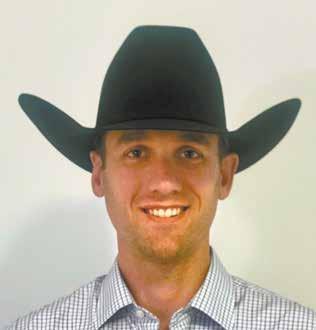
given point in time. Since last month’s article we have seen tariffs come and go and come again, efforts to streamline the National Environmental Policy Act, the formal ending of BLM’s Public Lands Rule Advisory Board and some pretty sizeable changes to the federal workforce with litigation involved all along the way.
NCA has been engaged with our partners, agencies, and Congressional delegation to ensure we continue to maintain the ability to do business at the speed of commerce and begin efforts to start chopping away at layers of regulatory burdens that NV ranchers face day in and out.
Finally, NCA will be sending a contingent to Washington D.C. in mid-April. During the trip we intend to discuss the laundry list of detrimental regulatory mechanisms our industry is burdened with, the overpopulation of wild horses, federal land designations, federal programs, and much more. This trip serves as a great opportunity for NCA to meet face to face with our Congressional representatives to discuss priority issues and for them to see and hear from producers who are impacted every day by the decisions they make.
Till next time.
management level of 259 to 536 wild horses in the area. If approved, the BLM would gather and remove the excess wild horses in the summer or fall of 2025 and implement population growth suppression tools to slow reproduction rates. This multi-year gather plan would also allow for similar actions when the BLM determines that wild horse populations exceed appropriate levels in future years.
Bill and changes for ESA, NEPA. Westerman wants an ESA overhaul. E&E NewsRepublicans have tried and failed to overhaul the Endangered Species Act for decades. This time could be different. House Natural Resources Chair Bruce Westerman (R-Ark.) is leading legislation that would take a significant swing at the law. Past attempts to amend the law have largely been stymied. But now some Democrats say they’re leaving the door open to negotiating with Westerman on the ESA. That’s a significant shift that could unlock a path for reforms in this Congress to a statute that has saved 99 percent of the species it has sought to protect.
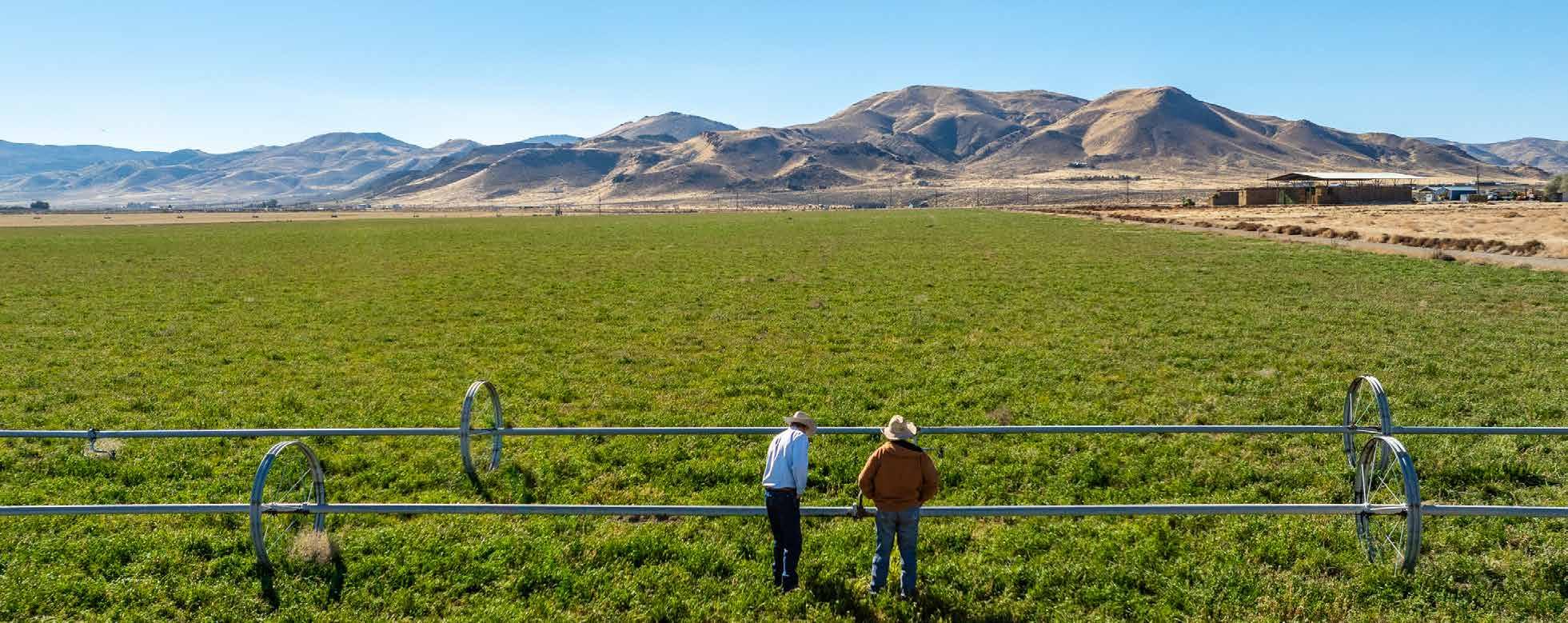

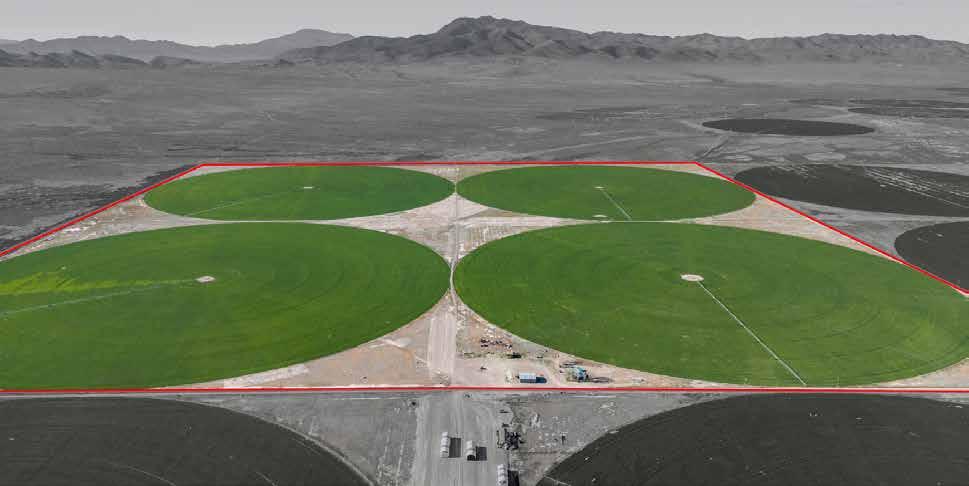


by Nevada Beef Council | Courtesy of the Cattlemen’s Beef Board
Cottonwood Ranch in Wells, Nevada, was recognized in February by the National Cattlemen’s Beef Association (NCBA) as a regional winner of the 2024 Environmental Stewardship Award Program (ESAP). Seven regional awards were presented to recipients during CattleCon 2025 in San Antonio.
“Conservation practices of cattle farmers and ranchers across the country help to preserve natural resources and provide wildlife habitat,” said NCBA President Mark Eisele. “The stewardship efforts of these award recipients confirm our industry’s commitment to protecting the land and water for future generations.”
Established in 1991, ESAP celebrates outstanding land stewards in the cattle industry. Regional ESAP winners come from every corner of the country and undertake stewardship efforts unique to their environment, landscape and resources. The 2024 Environmental Stewardship Award Program Regional winners are:
Region I: Angus Glen Farms, LLC, Watkins Glen, New York
Region II: Kempfer Cattle Company, Deer Park, Florida
Region III: Little Timber Farms, Blackduck, Minnesota
Region IV: Blue Ranch, Moore County, Texas
Region V: LeValley Ranch, Hotchkiss, Colorado
Region VI: Cottonwood Ranch, Wells, Nevada
Region VII: Downey Ranch, Wamego, Kansas
“Cottonwood Ranch has demonstrated for decades that they are exceptional stewards of the land,” said Marissa Reed, acting field supervisor of the U.S. Department of the Interior Reno Fish and Wildlife Office. “The ranch’s commitment to a collaborative approach for management of the private and permitted public lands has resulted in successful ecological and social outcomes.”
Cottonwood Ranch is a six-generation cow-calf and horse operation in Wells, Nevada. The Smith and Molsbee families are at the forefront of sustainable cattle ranching, realizing that wildlife, healthy lands and livestock can coexist and thrive together through managing both private and public lands as a whole. The ranch has an extensive history of working with federal and state partners to implement conservation practices and is a leader in utilizing virtual fencing for cattle. Cottonwood Ranch has implemented intensive grazing management strategies on their private
land that have created more diverse meadows. Diversification has also played a role in the ranch’s success, with the families expanding their business to include an events venue, hunting operation, veterans retreat and birding and wildlife learning center.
“I feel proud of what we have been able to accomplish,” said Agee Smith with Cottonwood Ranch. “We have been blessed to be caretakers of this land. It’s deeper than just a business, the land just gets in your soul.”
ESAP is generously sponsored by companies and federal agencies who share the cattle industry’s commitment to caring for the environment and protecting natural resources. Sponsors including U.S. Department of Agriculture Natural Resources Conservation Service, Corteva Agriscience, and U.S. Fish and Wildlife Service partner with NCBA to promote environmental stewardship throughout the beef supply chain. For more information, visit www.environmentalstewardship.org.



Korean chili pepper brings the Vietnamese Banh Mi to the next level. Spicy, rich, pickled and full of textures!
1 beef Cross Rib Roast or Chuck Arm Roast (about 2 pounds)
1 teaspoon freshly ground black pepper
1 cup Roasted Beef Stock*
1/4 cup Korean red chili sauce (Gochujang)
2 tablespoons minced garlic
1 tablespoon fish sauce (nam pla)
1 tablespoon hoisin sauce
1 tablespoon sambal
1 cup thinly sliced cucumber
1 cup shredded carrot
1/2 cup pickled ginger
2 tablespoons unseasoned rice vinegar
1/4 cup fresh lime juice
1/4 cup Classic Chopped Beef Liver Paté*
1 teaspoon plum sauce
1/2 teaspoon Cognac
2 tablespoons heavy whipping cream
6 banh mi or French bread rolls (5” long), split
1. Cut beef Cross Rib Roast into 2-to-3 inch pieces, season with pepper. Coat large nonstick skillet with nonstick spray; heat over medium until hot. Add half of beef; brown evenly, 3 to 4 minutes per side. Transfer beef to slow cooker. Repeat with remaining beef.
2. Add stock to skillet; cook and stir 1 to 2 minutes or until browned bits attached to skillet are dissolved. Stir in gochujang, garlic, fish sauce, hoisin sauce and sambal. Pour mixture into slow cooker. Cover and cook on HIGH 4 hours or LOW 6 hours or until roast is fork-tender. Meanwhile, combine cucumber, carrots, ginger and vinegar in small bowl. Cover and refrigerate.
3. Remove roast from slow cooker. Skim fat from cooking liquid. Reserve 1 tablespoon cooking liquid. Shred beef with 2 forks. Combine shredded beef, remaining cooking liquid and lime juice. Season with salt and pepper, as desired. Cover; keep warm.
4. Combine Beef Chopped Liver paté, reserved 1 tablespoon cooking liquid, plum sauce and Cognac in small bowl; mix well. Season with salt, as desired. Using a whisk, whip cream in small deep bowl to soft peaks. Fold cream into liver mixture. Cover and refrigerate until ready to serve.
5. Spread 2 teaspoons liver paté evenly over cut sides of each roll. Divide shredded beef evenly among rolls; top with cucumber mixture. Top with additional pickled onions, radishes, carrot, Thai basil, mint, sliced jalapeño peppers, cilantro and lime wedges, if desired.
*For instructions on making your own Roasted Beef Stock and Classic Chopped Beef Liver paté, visit www.beefitswhatsfordinner.com/recipes/recipe/55571/gochujang-beef-banh-mi-sandwiches
Nutrition information per serving: 582 Calories; 207 Calories from fat; 23g Total Fat (9 g Saturated Fat; 10 g Monounsaturated Fat;) 173 mg Cholesterol; 1148 mg Sodium; 37 g Total Carbohydrate; 3.8 g Dietary Fiber; 51 g Protein; 6.9 mg Iron; 6.7 mg NE Niacin; 0.6 mg Vitamin B6; 6.7 mcg Vitamin B12; 15.3 mg Zinc; 52.3 mcg Selenium; 199.3 mg Choline. This recipe is an excellent source of Protein, Iron, Niacin, Vitamin B6, Vitamin B12, Zinc, Selenium, and Choline; and a good source of Dietary Fiber.
Plant On Dryland Plant If Your Pivot Only Pumps 400gal/

On the Market since 1979 (and still unbeatable)

We are a non-GMO seed house! Never a positive hit for GMO

Greenway Alfalfa

Never a Report of Winter Kill

This Alfalfa has been called a tetraploid anomaly by alfalfa breeders. On the market since 1979, and being improved twice, It remains the highest yielding, low water alfalfa on the market!

HERE’S WHAT GROWERS ARE SAYING: (More testimonials available on our website)
When Planting Dryland Alfalfa always use coated seed! (Let us prove it!)
"We run out of water often times by June 1, but the 360-D yielded 6-3/4 tons! We’ve ordered another ton of 360-D"
Jordan Dillon - Rivers Edge Dairy - Hesperus, CO
“In our extremely tough and pure dryland conditions, 360-D has become our only ‘fall-back-mainstay’ variety.”
Max Wilson - Camas Prairie (elev 5060ft) - Fairfiled, ID
"360-D yielded 7 ton under a pivot that only pumped 375 gal./min."
Everett Messner - Salmon Track - Hollister, ID
“We planted 360-D in an irrigated pivot that was very short on water. Side by side was a pivot with normal water. The 360-D yielded with the well irrigated adjacent field! No difference in yield!
Ryan Telford - Richfield, ID

Alan Greenway Seedsman Over 50 Years Experience
Greenway Seeds Caldwell, ID
Alan Greenway 208-250-0159 (cell) 208-454-8342 (message)
√ Will produce AT LEAST 80% of crop with 50% of water
√ Will produce a subsequent cutting after water is gone
√ Plant on dryland/ guaranteed to out yield Ranger or Ladak
√ Plant under pivots that only pump 400 gal/
√ Plant on elds that have only early season creek water
√ Plant under end guns on pivots
√ Plant in the late fall with your dormant seeded grasses
* *Plant in your pivot corners. Two ton bonus per acre per year.
“Modern Forages Sold Nationwide and Canada”
Warehouses in Caldwell, ID and Deer eld, WI
As of 3/21/25
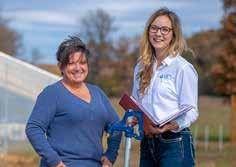


USDA has a solemn responsibility to be good stewards of the American people’s hard-earned taxpayer dollars and to ensure that every dollar spent goes to serve the people, not the bureaucracy.
As part of this effort, Secretary Rollins is carefully reviewing funding, including for programs that support urban and rural agriculture, and will provide updates as soon as they are made available.
Secretary Rollins fully supports the President’s directive to improve government, eliminate inefficiencies, and strengthen USDA’s many services to the American people. Secretary Rollins is committed to preserving essential safety positions and will ensure that critical services remain uninterrupted.
Environmental Quality Incentives Program (EQIP), Conservation Stewardship Program (CSP), and Agricultural Conservation Easement Program ACEP)
Regional Conservation Partnership Program (RCPP) and Conservation Innovation Grants (CIG)
Partnerships for Climate-Smart Commodities (PCSC)
Infrastructure and Investment Jobs Act (IIJA)
Direct payments to farmers are continuing unimpeded at this time This includes Farm Bill-funded contracts as well as Inflation Reduction Act-funded contracts that were obligated prior to Jan. 20.
All other contracting and agreement activities are under review.
Payments for work completed prior to Feb. 25, 2025, have been approved for payment. All new obligations, including supplemental agreements (SA), Programmatic Partnership Agreements and (PPA), and future Notice of Funding Opportunities (NFOs), are still under review.
PCSC activities are under review.
IIJA funds are under review. If asked to enter into
are under
for
and
PRODUCTION AND
USDA has many Service Programs & Initiatives! Visit this link to see them: www.nrcs.usda.gov/programs-initiatives
Some examples: Agricultural Conservation Easement Program
The Agricultural Conservation Easement Program (ACEP) helps landowners, land trusts, and other entities protect, restore, and enhance wetlands or protect working farms and ranches through conservation easements.
Agricultural Management Assistance
The Agricultural Management Assistance (AMA) helps agricultural producers manage financial risk through diversification, marketing or resource conservation practices.
Environmental Quality Incentives Program
The Environmental Quality Incentives Program (EQIP) is NRCS’ flagship conservation program that helps farmers, ranchers and forest landowners integrate conservation into working lands.
By Doug Busselman | NFB Executive Vice President
From the perspective of someone who has been engaged in the Nevada Legislature since 1989, nearly on a daily basis, there have been major changes over the course of the every-other-year sessions. Some of the changes can be recognized as improvements – others perhaps not as beneficial.
On March 18th, 2025, the 83rd Nevada Legislature recognized Ag Day 2025. It was during this event that the perspective on the degree of agricultural producers’ involvement really struck home. There was an outstanding presentation of the scope and diversity of Nevada agriculture, demonstrated in full display.
Thanks to the outstanding job of the Nevada Department of Agriculture in their coordination and outreach to invite different participants to be part of the exhibits, inside and outside the Nevada Legislative Building. Thank you as well to those who attended the 2025 Ag Day at the Nevada Legislature, whether as participants in exhibiting your stories or agricultural producers who came to show your support. Throughout the day there was a strong presence of agriculture’s strengths and merits communicated to Legislators and others who are part of the legislative process.
We also saw, firsthand, the authority of farmers and ranchers when the Nevada Senate Commerce and Labor Committee held their initial hearing on SB 172. This bill seeks to remove the exemption that agriculture has from the requirements of paying overtime. It also includes negative elements that are embodied in a section of the bill labeled as the “Agricultural Workers’ Bill Of Rights.” Those advancing this legislation want to change Nevada’s agricultural labor systems to incorporate unionization, collective bargaining and greater opportunities for regulation through the Labor Commissioner.
During the legislative committee hearing there was a strong turn-out of farmers and ranchers, in person and on the call-in phones for giving their input to the committee. There was also references made to the number of emails that went to the Legislative committee members, coming from farmers and ranchers.
Those who called in, supporting passage of the bill, weighed in with their only comments being that they were of whatever union they are members of and saying that they support the bill.
The differences between those supporting and those opposing SB 172 was night and day. Those calling in, saying that they supported the bill, wouldn’t be impacted by whether the legislation passed or not. The agricultural producers who weighed in with their input would all be impacted directly by the consequences that this bill would have.
Thank you to those who were part of this hearing and for those who have contacted legislators since that took place!
Given the make-up of the Senate Commerce and Labor Committee there is a high likelihood that the bill will be passed from committee and advance to the Senate floor. Whether SB 172 will be amended is unknown and for our part we have not attempted to persuade any changes to be included. There is not any common ground available -- as an attempt to make an unworkable system less unworkable.
Meanwhile, we continue to make connections with members of the Nevada Senate to express our opposition and we encourage others to do the same…by phone, emails or personal visits.
The advances in being able to communicate with members of the Nevada Legislature are one of the major enhancements that have come about over the course of the years. The Nevada Legislative Website at https://www.leg.state.nv.us offers a great opportunity for Nevadans to be directly involved in the legislative process.
For those who visit this website, the “Session Info” pull-down tab (in the upper right-hand corner) gives you the ability to click on the “83rd (2025 Session” option and choosing on the options in the left-hand column for either “Bill Information” in the NELIS version or the “Classic” version. (My personal preference is using the “Classic” version and with a mouse click, I’m taken to the page with options for Assembly Bills or Senate Bills as well as the various “Resolution” types that are also provided for either of the two legislative houses.)
When you select to use the NELIS version of Bill Information and select a bill to review on NELIS you will be able to not only find various details for the legislation, but also on the upper righthand corner of the information you will find an “Opinion” button that you can mouse click and type in your views on the bill, supporting, opposing or are neutral.
The “View Events” button, in the upper righthand corner of the website, provides a pull up of all the committee meetings that have been scheduled for the day, as well as their agenda and links for the bills that will be worked as part of their business for the day. In the left-hand column of the Committee Meetings, you are provided with the ability to click on and view the “live” meeting when that session is occurring.
A tab below the “View Events” button you also have the ability to go back and watch “Videos and Archived Events” which include past committee meetings, floor sessions and a variety of other recordings.
Midway down the Legislature’s Home Page, in the left-hand column, you’ll see the tabs for “Assembly” and below that tab, “Senate,” selecting the “Legislator Information” option you will be presented with a listing of the legislators in either the Assembly or the Senate and their contact information. This information can provide you with the email address to use in writing and sending emails or obtaining the legislator’s office phone number to call. Those calls are taken by the members’ attaché who you can work with to share your opinion or seek to make appointments to visit at the Legislative Building the member on a faceto-face basis.
Your engagement with the legislative process and staying in touch with your elected representatives is essential. NFB is here to work with and help you. If you have questions, comments, inputs or simply want to talk about what is taking place, please don’t hesitate to drop an email at doug@nvfb.org or call (775) 870-3349.


We are saddened to report that Marlene Shier, past chair of the Nevada Farm Bureau Women’s Leadership Committee, passed away on April 1st. Marlene, of Winnemucca, served as chair of the committee from 2019 through 2024. Prior to becoming the chair of the Women’s Leadership Committee, she served as the vice chair of the committee.
In addition to her role with the State Committee, Marlene was also active in leadership for the Humboldt County Farm Bureau, serving on the county Farm Bureau Board of Directors for many years. Our condolences to Marlene’s family for their loss.
As we draw closer to April 15th, it should be a clear reminder of the importance of Congress to move forward with the renewal of the Tax Cuts and Jobs Act before December 31st of this year.
Samantha Ayoub, associate economist of the American Farm Bureau Federation continued with the on-going series of Market Intel reports that have been highlighting different elements of the legislation needing attention through this renewal process. Her recent background piece (www.fb.org/marketintel/2025-tax-cliff-capital-investment-expensing) covered two vital elements for farmers and ranchers – Section 179 and bonus depreciation.
Setting the stage Ayoub noted that modern farming is capital intensive. She further explained that the cost of the assets that producers need, such as land, machinery and technology, continue to rise even as market receipts stay low.
Agricultural producers would typically pay taxes on the money that they use to purchase assets, she noted. Under the provisions of the Tax Cuts and Jobs Act important tools to lower their tax liability includes Section 179 and bonus depreciation.
The Senate Growth and Infrastructure Committee held a hearing on SB 180 which proposes to require a doubling of the federal minimum liability insurance requirement for vehicles of 26,000 lbs. or greater. The limits being proposed under the bill would require $1.5 million for intra-state freight movements in vehicles of 26,000 lbs. or greater. At the time of the hearing, the sponsor of the bill, Senator Edgar Flores announced in his opening remarks that they would be working off the proposed amendment which basically offers a ratchet proposal to drop the burdens on in incremental increases.
NFB was one of several organizations and individuals who testified in opposition to the legislation. Nevada Farm Bureau’s testimony noted that as the bill is written, farmers and ranchers would be required to comply with the “freight” that they transport for themselves. This would include even transporting harvested crops to their own property, when using highways. Farm Bureau provided a case-study scenario of what the costs would be for farmers and ranchers, hauling their own products and being forced to purchase additional umbrella coverage to reach the newly imposed burden for liability. Rough estimates would be an additional $2,000 to $5,000 per year.
American Farm Bureau Federation President Zippy Duvall commented on April 2nd about President Trump’s announcement that the United States will impose reciprocal tariffs on trading partners.
“Trade is critical to the success of farmers and ranchers across the country. We share the administration’s goal of leveling the playing field with our international partners, but increased tariffs threaten the economic sustainability of farmers who have lost money on most major crops for the past three years.
“More than 20 percent of farm income comes from exports, and farmers rely on imports for crucial supplies like fertilizer and specialized tools. Tariffs will drive up the cost of critical supplies, and retaliatory tariffs will make American-grown products more expensive globally. The combination not only threatens farmers’ competitiveness in the short-term, but it may cause long-term damage by leading to losses in market share.
“We encourage the administration to work toward a swift resolution to trade disagreements to avoid tariffs that put farmers and ranchers in the crosshairs of retaliation, and to pursue strategies that expand market opportunities for the men and women who grow the food every family in America relies on.”
Two important, priority water bills have been given favorable votes in the Natural Resources Committee of both legislative bodies. AB 104 passed on a unanimous vote in the Assembly Natural Resources Committee and a day later SB 36 was passed unanimously in the Senate Natural Resources Committee. Both bills received extensive amendments, primarily geared to changes to avoid a fiscal note which might affect the possible future for the bills. We hope that we’ll be able to provide the 1st Reprint of both bills in the near future. The core purpose for these bills involves setting up a legislatively authorized voluntary purchase program of water rights in over-appropriated and over-pumped groundwater basins with the acquired water rights being retired.
Nevada Farm Bureau testified in support of AB 479 when it was heard by the Assembly Growth and Infrastructure Committee on April 1st. The bill also has a conceptual amendment that Nevada Farm Bureau spoke to as making a good bill even better. AB 479 would cover any concerns over the use of agrivoltaics on private land and still maintaining the important property tax treatment that eligible agricultural lands now have.
While NFB policy doesn’t cover the concept of not having our clocks moved forward in the spring and back in the fall, we’ve been asked by a number of folks who have been interested in the progress of the “Lock the Clock” bill (AB 81) It passed, with an amendment for when the bill would become effective, by the Assembly Government Affairs Committee on March 31st. If the bill gains full passage into law, Nevadans would change their clocks back to Pacific Time in November and not readjust their clocks in 2026.
Join the Clark County Farm Bureau at the Clark County Fair and Rodeo April 9th through the 13th. NFB members receive discounted ticket rates. Tickets must be purchased before April 8th at 8 p.m. To purchase tickets please click Here or call: 1-888-876FAIR Make sure to enter promo code: BATLCF25
Discounts are as follows:
20% off Daily Fair Admission
20% off Wednesday or Thursday Rodeo/Fair
*Ticket fees are only charged on online orders.
By Nancy Chapman, The Fallon Post
In 2022, several professional rodeo cowboys rode into the Oasis of Nevada, ready to take on some of the sport’s toughest broncs. They came for the inaugural Battle Born Broncs, a Professional Rodeo Cowboys Association (PRCA) sanctioned bronc riding event in the newly completed Rafter 3C Events Complex.
Battle Born Broncs has set the stage for other professional rodeo productions at 3C, helping establish Fallon as a Western heritage destination. Now in its fourth year and with strong backing from the City of Fallon, Churchill County, and many dedicated sponsors, the event is raising the bar for rodeo excellence in Nevada.
This year, Battle Born Broncs moves from its traditional June Thursday night slot to next month. Rafter 3C officials and Darcie Spero, Battle Born Broncs founder and producer, elected to host the Xtreme Broncs event for April 18-20, 2025, to coincide with Fallon High School Rodeo weekend to give youth contestants a rodeo experience that will help them look to their future.
Jesse Segura, Rafter 3C Deputy Director, the City of Fallon, and Spero have scheduled five college rodeo
coaches from Cal Poly, Fresno State, Univerity of Nevada Las Vegas, College of Southern Idaho, and Feather River College to speak with the high school rodeo athletes. Coffee with the Coaches will allow contestants to learn about college rodeo and programs of study offered at the represented schools.
In addition, Battle Born Broncs is hosting a youth training camp on Friday, April 18. Aspiring rough stock riders will learn about safety and technical skills in the arena and the importance of health and fitness.
This year, six-time world champion bareback bronc rider Kaycee Feilds, and Luke Branquinho, fourteentime NFR qualifier and 5-time world champion steer wrestler, will be among the professionals sharing their knowledge of what it takes to be a champion.
The schedule change also benefits stock contractors, who must meet summer rodeos’ demands in California, where contestants and contractors participate in multiple events on the same weekend. Battle Born Broncs stock contractors will bring their top PRCA bucking horses - thirty bareback and thirty saddle bronc, to test their mettle against top-ranking riders.
Riders will compete for $50,000, two coveted trophy bronzes, and other prizes valued at $10,000. All money won at this event counts toward the PRCA World Standings, determining the fifteen contestants qualifying to compete at the Las Vegas National Finals in December.
Vendors will be set up in the mezzanine Friday through Sunday, closed Saturday from 2-5 p.m. to allow set up for the Saturday night PRCA bareback and saddle bronc performances. The Welcoming Party is on Friday, April 18, at 6 p.m. at Rafter 3C, featuring The Cash Prophets band (the gospel according to Johnny Cash). Sponsored by Sizemore Construction, the event is open to the public. The Cowboy Calcutta will be on Saturday, starting at 7 p.m., at the Rafter 3C Complex during the competitor’s dinner. The performances will begin at 8 p.m. Doors open at 5 p.m. on Saturday.
The Cowboy Channel will be filming the action and airing the following week. The way to see the excitement in real time is to attend the performances. Tickets can only be purchased online at battlebornbroncs.com.
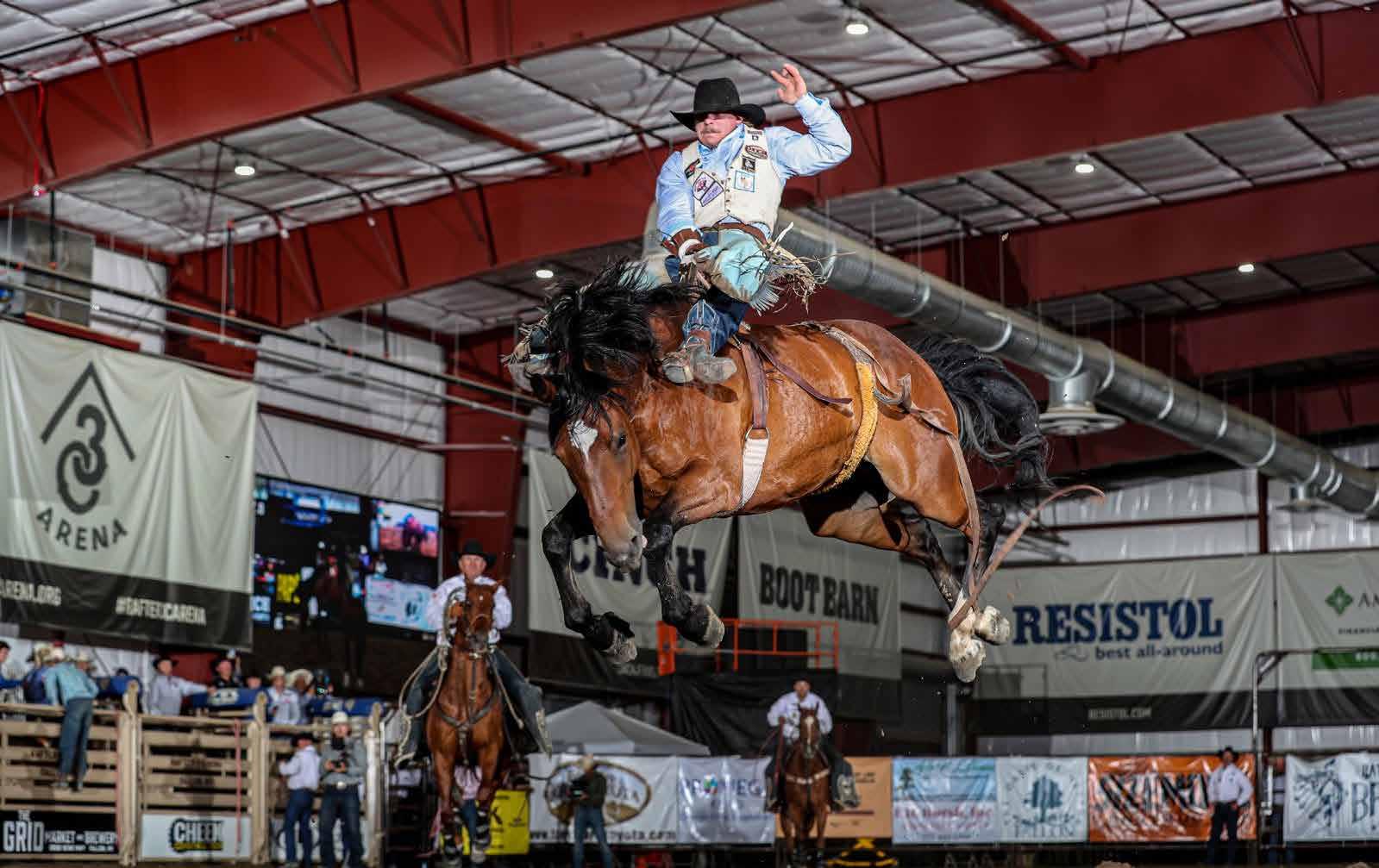
Keenan Hayes in 2023; he went on to be the World Champion Bareback Rider in the same year.
Photos
by Hailey Rae Photography
Kade Bruno, 2x NFR Qualifier on Sankey Pro Rodeo Company and Phenom Genetics “Mugilla.”
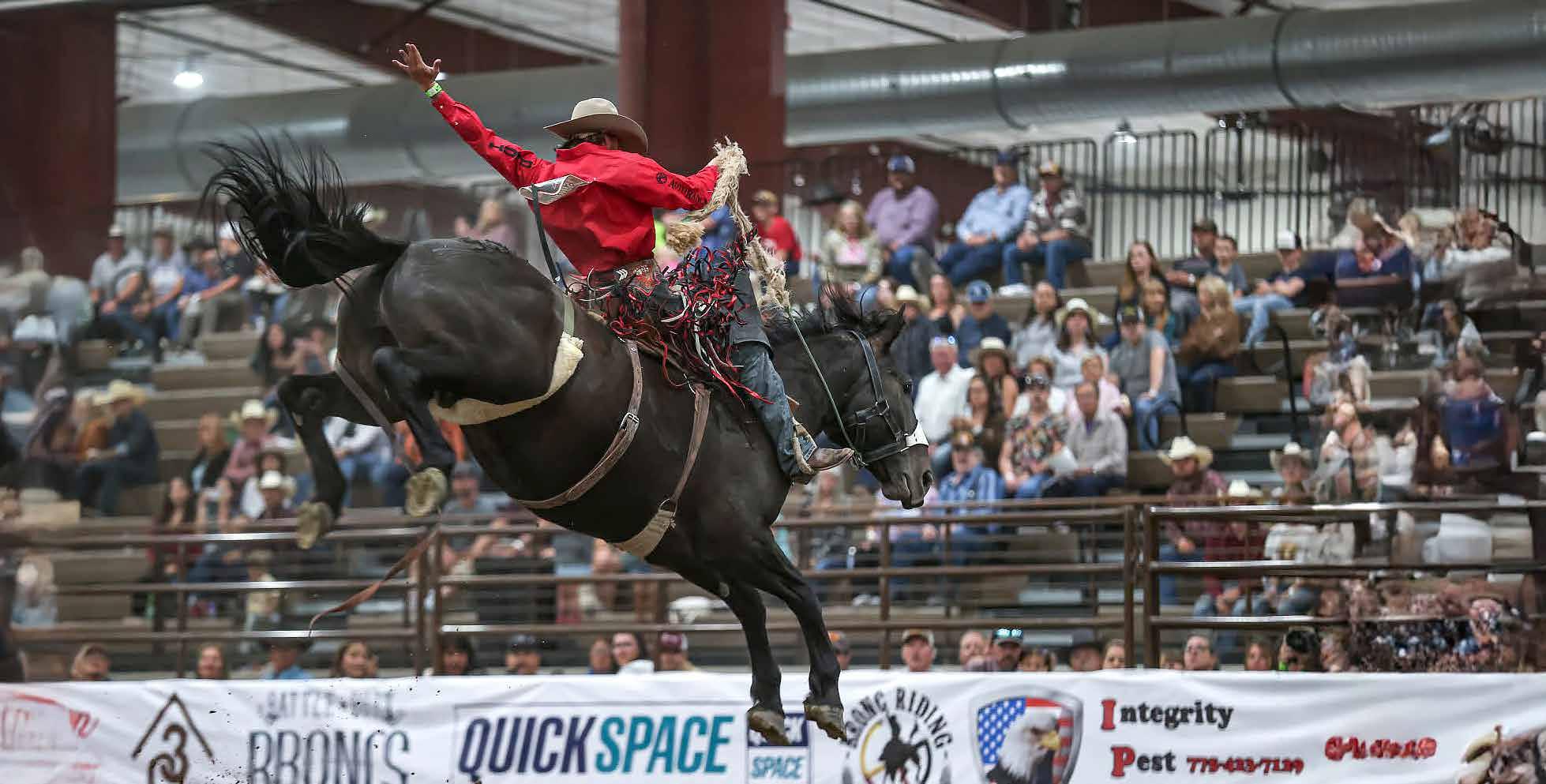
If you’re looking to sell a farm or ranch, give us call!
Offering a 50% interest in the Deeded Fish Creek Ranch with all the Ag use to the buyer. Lots of irrigation water from springs that arise on the ranch. Mine owner wants to reserve some water rights and Sage Grouse Credits. 2957 deeded with approx. 2000 water righted out of the springs, 5 homes plus multiple other barns, shops and outbuildings. $3,000,000
This farm in Railroad Valley 320 acres with 240 acres of Certificated Water rights. Custom home 55% complete. Not far off Hwy 6 and in the same valley as the farm above. $900,000 Call Paul on this one 775-752-0592




“Plowdown” alfalfa with your regular alfalfa seed. Expect a hearty yield increase your “new seeding” first year!
“Plowdown”






Most of Nevada is abnormally dry with extreme drought in southern Nevada as the irrigation season begins, bringing the big question of what is hay going to be worth this year.
I did some research on what economists say hay prices will be this year. If you remember last year, hay prices were the lowest they had been in a while. What my research found, is prices depend on the weather. The story is always the same, but there also are expected to be higher input costs related to production.
There are some economists that explain that hay supply was high in 2024 and that is what drove prices low. The problem is that there is no futures market for alfalfa hay and there is limited price reporting. This leads to speculation. Economists from Utah State Extension have a user-friendly web-based alfalfa pricing tool for the Western states. They say it can be used for current price information and price forecasts up to 9 months into the future for the State of Utah. Their hay prices online tool is available at: https://farmanalysis.usu.edu/static/hay_pricing/Hay%20Pricing%20Tool/ Hay%20Pricing%20Tool.htm
Below is a graphic provided by the economists looking at hay prices over time for seven western states. Data is always interesting as I reflect on Nevada’s hay prices relative to the other Western states. I also look at our prices related to California, Utah and other surrounding states.
By Staci Emm | Editorial
Feuz, D. & Larsen, R. Predicting Current and Future Alfalfa Hay Prices in Seven Western States, Utah State Extension.
The California Direct Hay report this month states that retail hay demand was good, dairy hay demand was light, and export hay demand was light. The next report will be out around March 28. Ag West Farm Credit reported that hay prices remain low, and buyers are remaining price sensitive. California and Arizona first cuttings have begun with optimal weather. According to Ag West, hay producers should not expect major increases in hay prices unless severe drought occurs.
Well, with drought, we have southern Nevada starting to hit the extreme drought. The drought monitor for March is showing signs of drought starting to occur. Below is a snapshot of the drought monitor last reported for Nevada. I always find that USDA hay price reporting is a bit off, but judge it for yourself. The Pacific Region Nevada Hay Prices chart is available at: https://www.nass. usda.gov/Statistics_by_State/Nevada/Publications/Crop_Releases/Nevada_ Hay_Prices/2025/202501NVHAY.pdf
We know things may get a little tough out there depending on weather and what input costs we face with fuel, parts, and other expenses. This is not new to those in the business. USDA has just announced billions in support to producers. I am waiting to see the new program rolled out by Farm Service Agency. I do sincerely hope that it covers alfalfa and other hay.
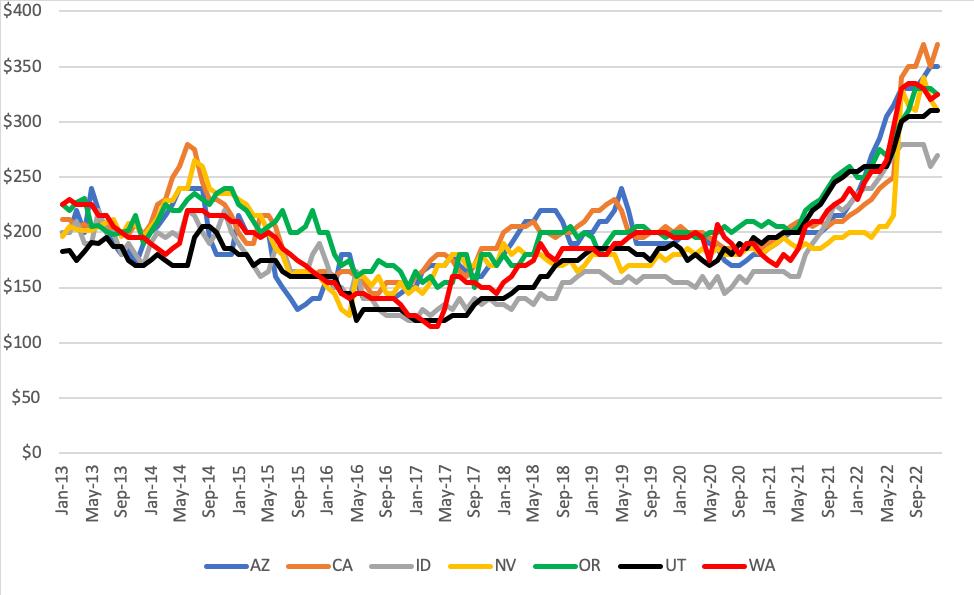
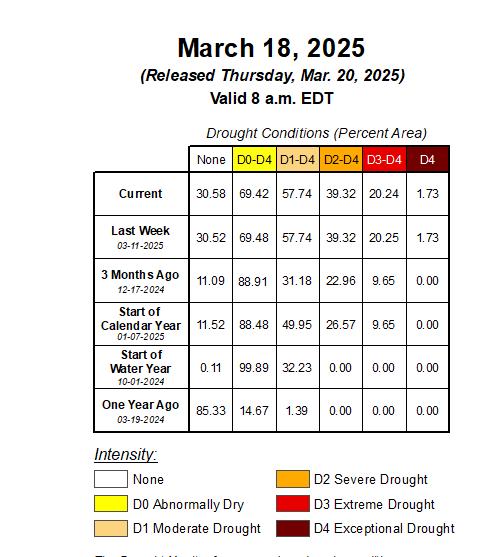
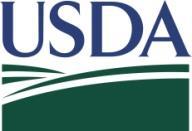
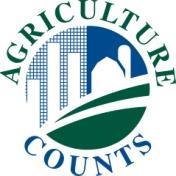
State Reports | https://www.nass.usda.gov/Publications/Subscribe_to_State_Reports/index.php
National Reports | https://usda.library.cornell.edu/ and https://www.nass.usda.gov/Newsroom/Subscribe/index.php
Thank you to the Farm Bureau leaders and members who came to Carson City and joined in the celebration of Ag Day at the Legislature on March 18. We are grateful to the Nevada Department of Agriculture for their outstanding coordination in pulling the diverse groups together to promote Nevada agriculture.
Nevada Farm Bureau’s promotional effort linked to having the freshly upgraded Ag Wagon on the outside entry to the Legislative Building along with the Nevada Department of Agriculture’s milking cow and the Extension mobile meat processing unit where steak cubes from Wolf Pack Meat were prepared and served.
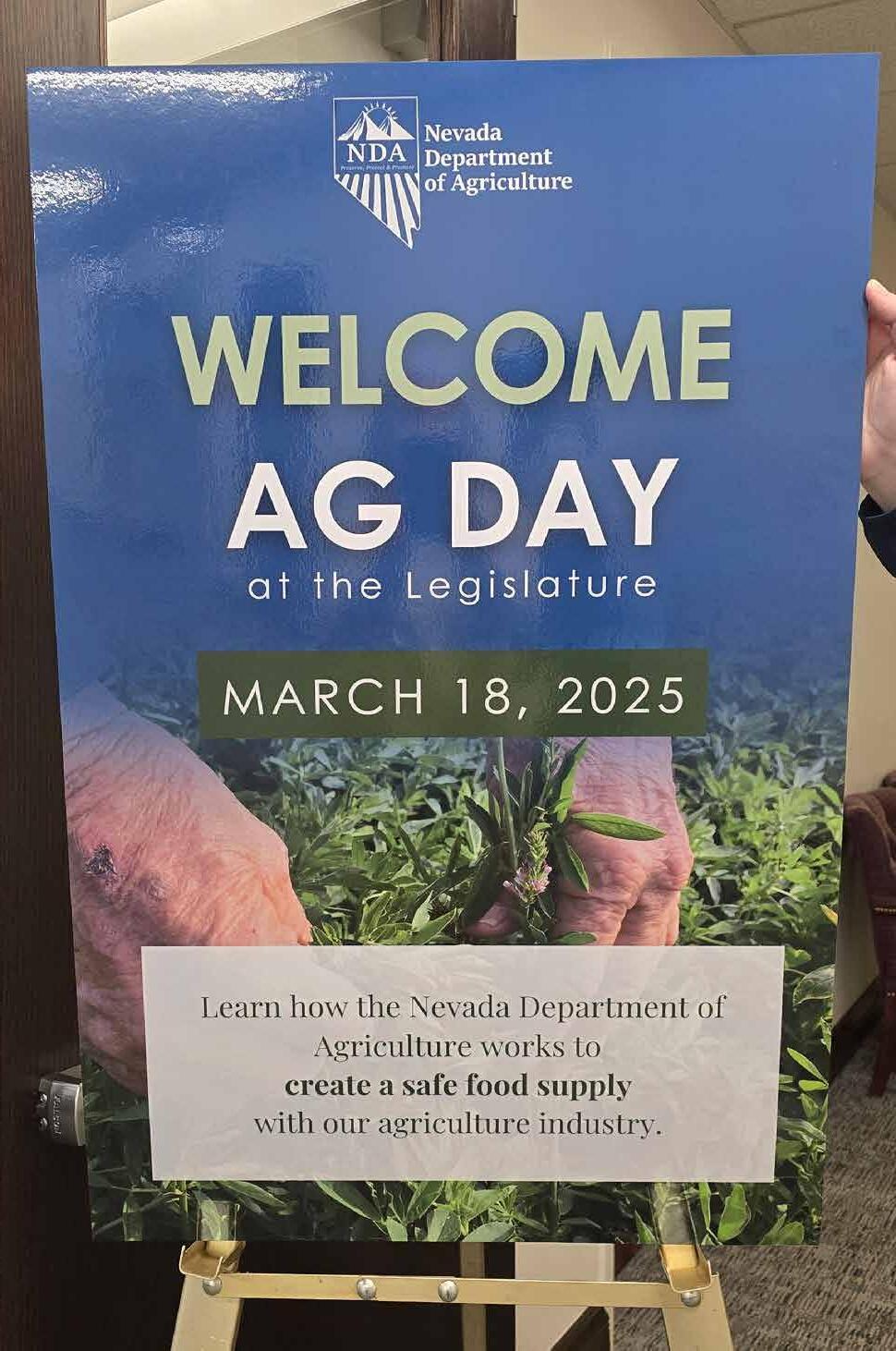




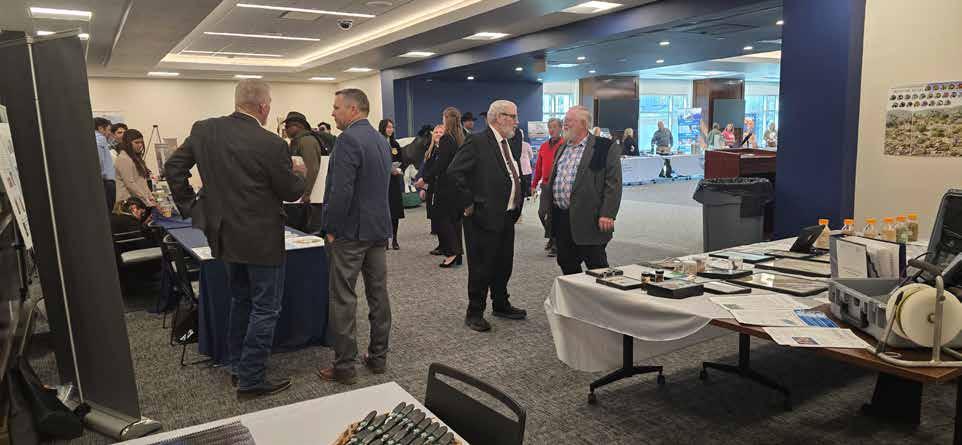
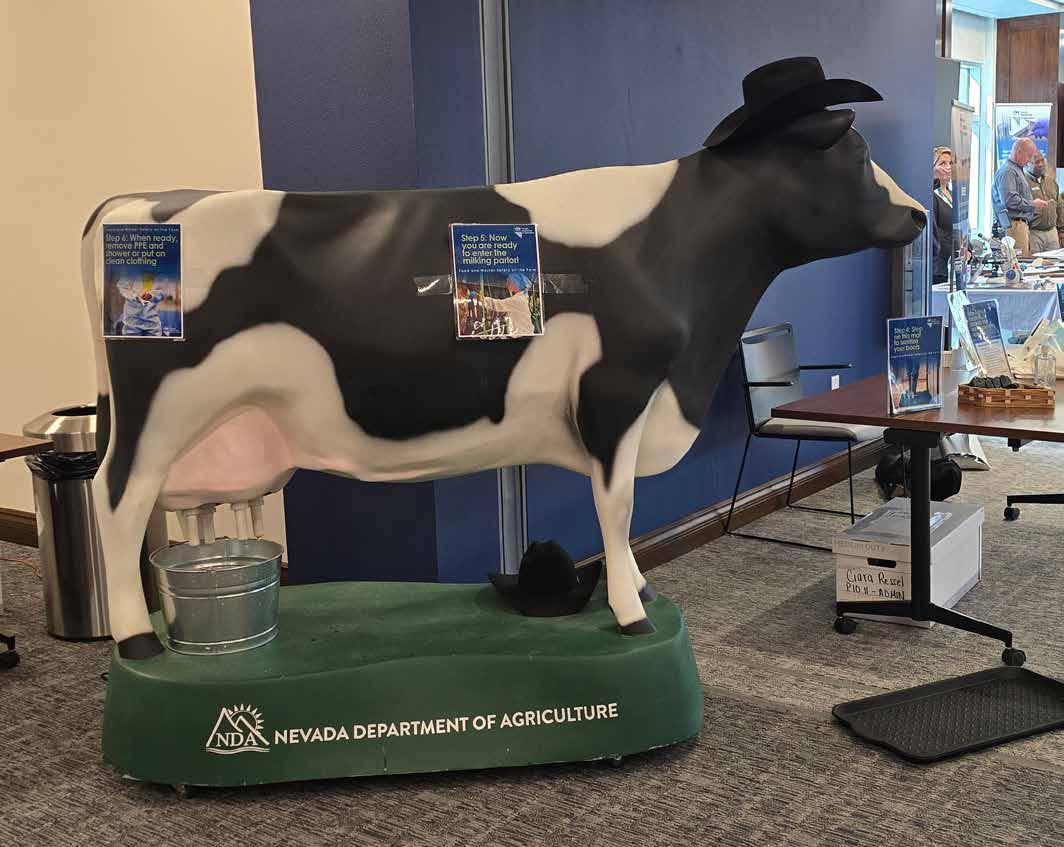


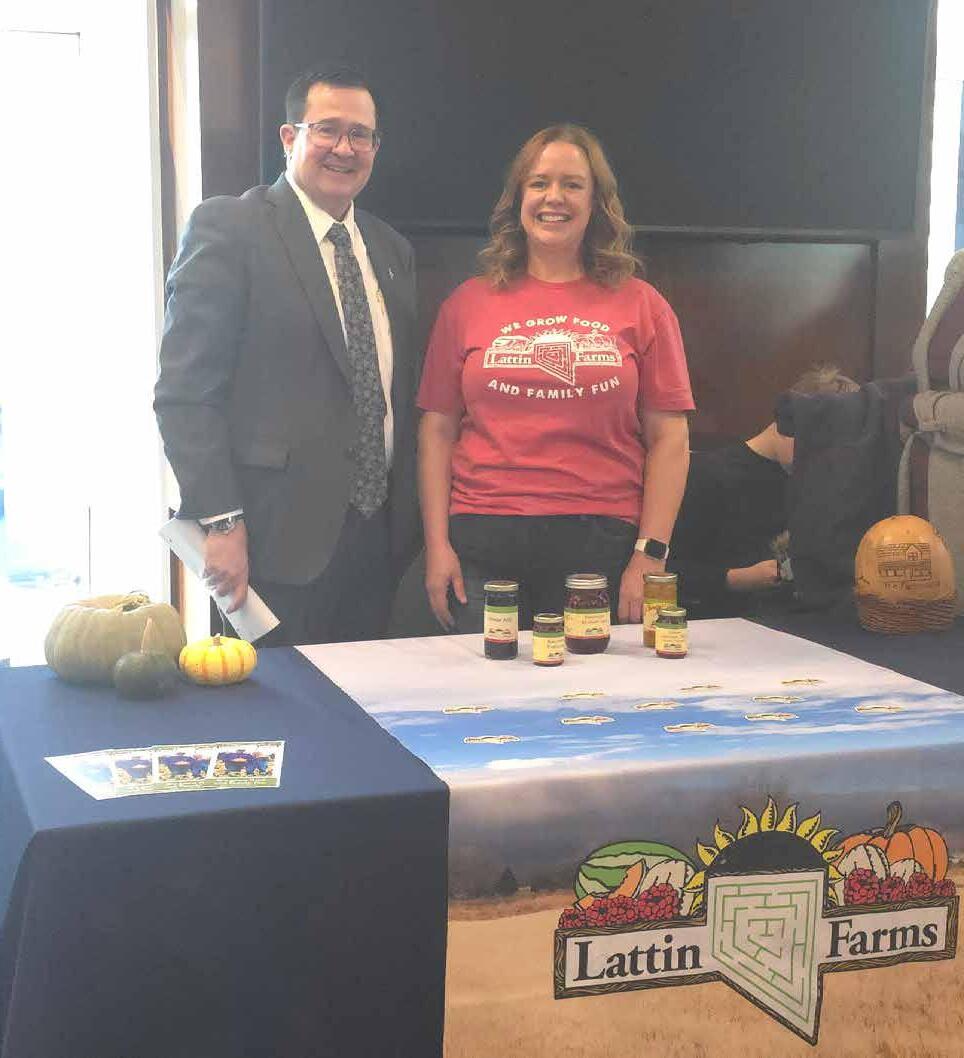





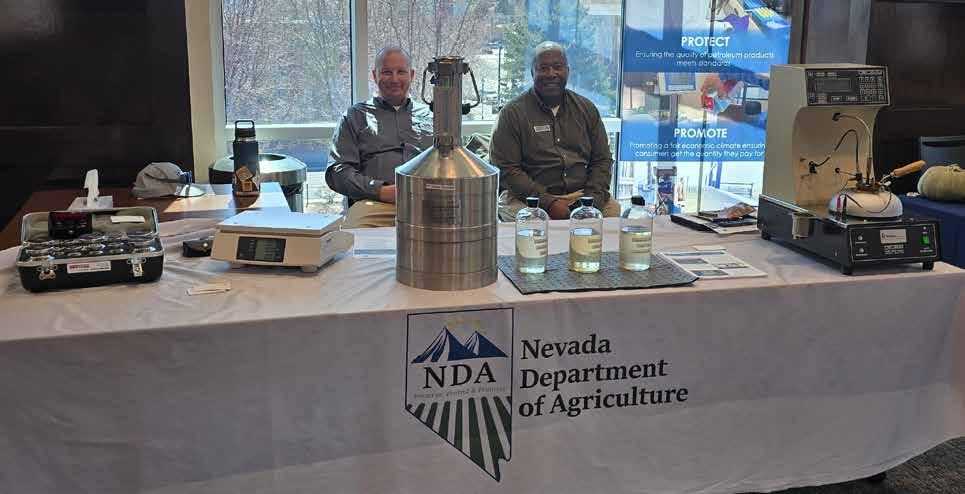




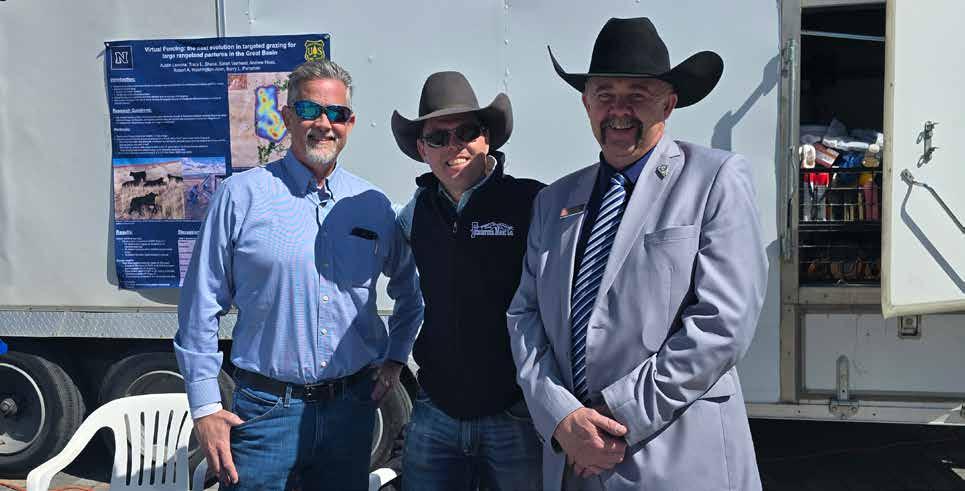
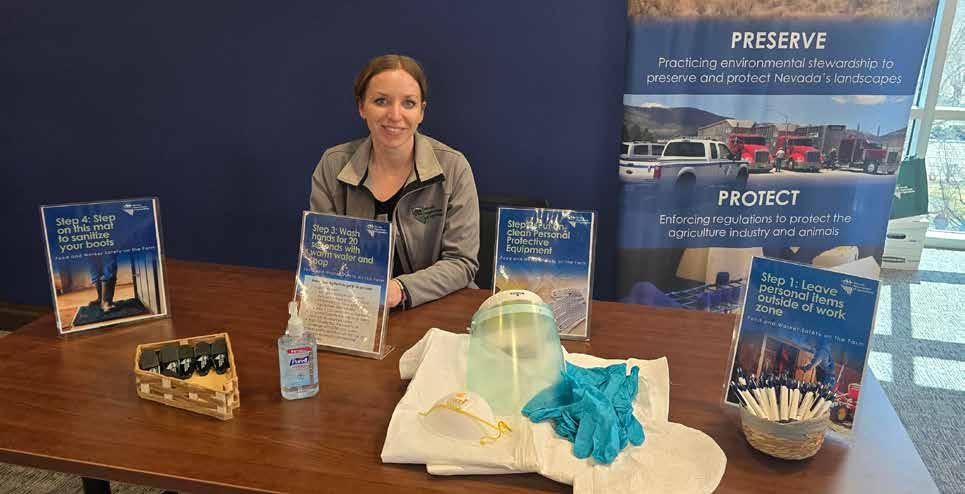

WHEREAS, Agricul ture Day is celebrated to honor the contribution to our State by the industrious Nevadans along the food and agricul ture supply chain; and
WHEREAS, recognizing Agricul ture Day provides the opportunity for all Nevadans to appreciate the bread th and beauty of Nevadaʼs food and agricul ture industries; and
WHEREAS, Agricul ture Day highlights how food, fiber and fuel products are produced as well as the role Nevada farmers and ranchers play in providing safe, high-quality products, despite drought, adverse weather, pests, and disease; and
WHEREAS, the distinction of Nevada agricul ture is buil t on a solid history of good stewardship of the land and sustainable agricul tural practices; and
WHEREAS, 3,122 farms and ranches cover more than 5 9 million acres across the Silver State, both urban and rural; and
WHEREAS, livestock and the production of al fal fa hay, allium crops (onions and garlic), and various crops, fruits and vegetables contribute to the Stateʼs economy; and
WHEREAS, Nevadaʼs food, beverage and special ty product manufacturers make up a significant segment of agricul tural economic impact for the state with an economic output of over $5 3 billion in 2024;
WHEREAS, food and agricul ture is one of Nevada's most vital industry sectors, employing over 19,000 Nevadans and contributing $6.5 billion to the state's economy in 2024;
WHEREAS, on Agricul ture Day in Nevada the food and agricul ture sector of Nevada are recognized for providing the food, fiber and fuel to sustain our communities, their contributions to Nevadaʼs economy through production, exports and employment, and conscientious stewardship of the land for future generations of farming and ranching in the Silver State;
NOW, THEREFORE, I, JOE LOMBARDO, GOVERNOR OF THE STATE OF NEVADA,
DAY

WITNESS WHEREOF

By Charlie D. Clements
One of the most influential factors on antelope bitterbrush population dynamics is fire. Rangelands dominated by woody vegetation suggest the absence of fire, whereas dominance by herbaceous vegetation suggests the presence of fire. Wildfires are a natural feature of the environment. For more than a century and a half, human interference with fire and other natural processes has greatly influenced western rangelands. Plant communities always reflect their species composition, spatial distribution, and demography how the previous plant community that occupied the site was destroyed. This is known as the stand renewal process. If the stand renewal process has been consistently catastrophic over-time the natural plant community will have evolved under selection pressure associated with characteristics of the stand renewal process. Seed germination and seedling establishment will be adapted to the stand renewal process or a vegetative process; stem, root crown, or root sprouting will have been selected to renew the stand.
During most of the 19th century and into the 20th century, there has been a concentrated effort in the United States to suppress wildfires on range and forest lands. Promiscuous burning was associated with the mismanagement of natural resources for decades, but more recently fire has been more widely accepted as a necessary part of wildland ecology. Native Americans are reported to have used fire as a tool for many purposes such as communication, hunting and forage manipulation. Native Americans also pointed out the benefits of burning habitats to improve nutritional value of forages as well as attracting native ungulates to these manipulated habitats for much needed resources. European settlers brought domestic livestock which resulted in extensive season-long grazing that significantly reduced fine fuels needed to carry fires. Most authorities agree that the reduction in perennial grasses in turn reduced the competition for shrub seedlings and increased their chances of establishment. The decrease in fire frequencies resulted in the transition from herbaceous-
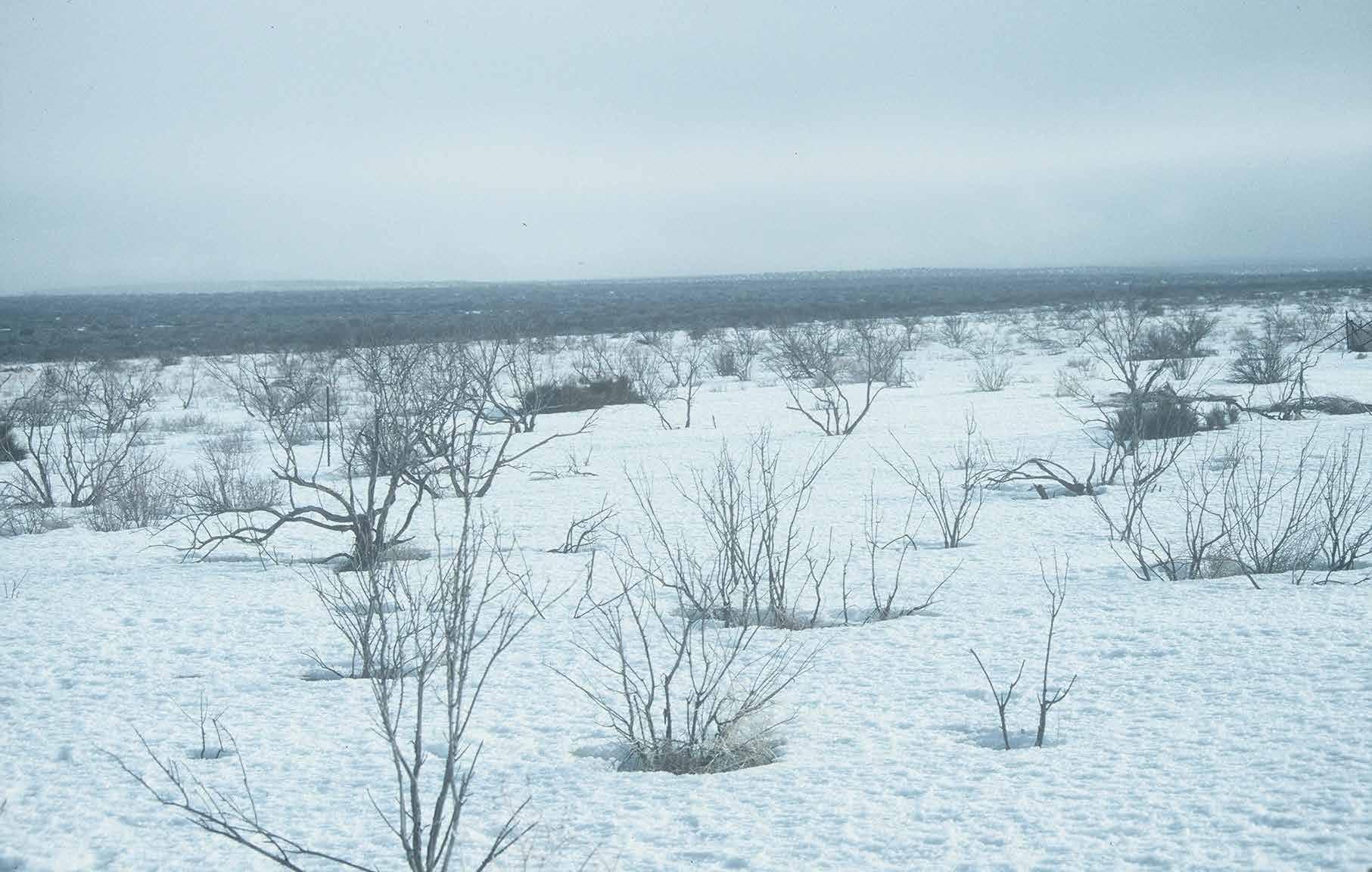

dominated communities to landscapes dominated by woody species. The native perennial grasses that fueled wildfires did not dry sufficiently to carry fires until late summer and early fall. Plants that flowered in the spring and matured in early summer, such as antelope bitterbrush, had an advantage over species that flowered and set seed following wildfire season, such as big sagebrush. Antelope bitterbrush seeds were safely cached in the soil prior to the wildfire season by granivorous rodents, whereas late season wildfires destroyed the non-sprouting big sagebrush stands before seed was produced. Sprouting shrub species, such as rabbitbrush, quickly occupied the burned site until enough time had passed for the return of big sagebrush. Researchers have reported that the frequency of wildfires must have been at least 60 years or longer, otherwise there would not have been very little big sagebrush present for the next wildfire as reported. Big sagebrush does not build persistent seed banks, and the seeds have limited seed dispersal mechanisms as granivorous rodents do not harvest and cache this seed nor does this seed disperse very far from wind, commonly reported to be 3-6’ from mother plant.
Fire plays a crucial role in the seed and seedbed ecology of antelope bitterbrush. The timing of wildfires is of particular importance, as are the conditions of the year that the fire occurs. In some years, antelope bitterbrush seed production may be low or non-existent because of late frost, insect outbreaks, excessive browsing, severe droughts or a combination of these occurrences. Because the seed banks of antelope bitterbrush are controlled by granivorous rodents, there may be no seed reserves available if the stand burns during a poor seed production year. Also, if the stand burns while the seed crop is still on the plant, all is lost. Because the timing of wildfires is critical in the seed and seedbed dynamics of antelope bitterbrush, anything that affects wildfire timing also affects antelope bitterbrush survival. The accidental introduction of cheatgrass increased the chance, rate, spread and season of wildfires throughout the Intermountain west. The fine-textured early maturing cheatgrass herbage dries six weeks to two months prior to
native perennial bunchgrasses, and in years when cheatgrass is abundant, the chances of ignition and rapid spread of wildfires are greatly enhanced. The change in the season of wildfires to early summer is catastrophic to antelope bitterbrush stands (Fig. 1).
August Hormay, in his pioneer research on antelope bitterbrush, had a very simplistic view regarding the influence of wildfires, “Fire kills bitterbrush in most instances in California.” Another pioneer researcher on antelope bitterbrush was Emor Nord, he agreed that wildfires were devastating to antelope bitterbrush populations and noted that the resprouting of antelope bitterbrush following wildfire was common in some instances. In the nearly four decades of researching and managing antelope bitterbrush in norther Nevada and northeastern California, the U.S.D.A. Agricultural Research Service, Great Basin Rangelands Research Unit has reported the average level of resprouting of antelope bitterbrush following wildfires at 13%, far too low to sustain an antelope bitterbrush population (Fig. 2).
The arrangement of fuels is highly variable in antelope bitterbush communities because of the wide variety of growth forms the plant can
assume. The short statured types have a spreading crown with many find limbs located close to the soil surface and to fine-textured herbaceous fuels. Upright forms in ponderosa pine woodlands can accumulate needles in their canopies that flare up, igniting the tree understory. The invasion of cheatgrass has found safe sites beneath the shrub canopies as well in the interspaces which increase fine-textured early maturing fuel that can result in catastrophic wildfires. The different fuel types result in different resprout ability, but this resprout ability is often too low of a percentage to sustain the antelope bitterbrush community. Often, these resprouts are very nutritious but provide less overall biomass and are therefore consumed by browsers such as mule deer which can lead to overutilization and added mortality. Emor Nord pointed out how attractive sprouting browse species in burned habitats are to animals and the damage caused by the concentration of these animals and what this concentration can do to post-burn succession, especially antelope bitterbrush. Also, following wildfires, resprout antelope bitterbrush plants resulted in reduced cover, flower production and seed production. Many early wildlife managers
vocally spoke out against the use of prescribed burning as they protested that prescribed burning was destroying mule deer habitat.
The accidental and subsequent invasion of cheatgrass throughout the Intermountain west resulted in an increase in wildfire frequencies that put antelope bitterbrush populations at high risk. In the event of post-fire seeding of antelope bitterbrush, successful seedings of this critical browse species still require 6-10 years before these new antelope bitterbrush shrubs flower and produce seeds. With this risk of burning every 10 years or so, the next frequent wildfire assures the depletion of antelope bitterbrush seed from that site. Antelope bitterbrush shrubs peak at about 60-70 years of age, followed by a reduction in nutritional value as well as a decrease in leader production, flowering and seed production. Our research has reported antelope bitterbrush seed production on 30-40 year old shrubs at more than 100,000 seeds per shrub, compared to less than 1,000 seeds per shrub on 80+ year old plants. Our research also pointed out that granivorous rodent harvest more than 98% of the bitterbrush seed that falls to the soil surface. Birds and ants pretty much harvest the remaining seed.

If there is less seed production, then the portion of the seed that the granivorous rodents harvest and take back to their burrows results in a significant decrease in scatter hoard aches that the rodents do within their home range, which is the primary recruitment mechanism for antelope bitterbrush (Fig. 3). This decrease in scatter hoard caches becomes even more problematic due to the level of antelope bitterbrush seedling predation by these granivorous rodent, roughly 86%. This is a recipe that has played out in many antelope bitterbrush plant communities, as this shrub gets old and decadent it lacks the sufficient annual recruitment necessary to sustain the current antelope bitterbrush plant population (Fig. 4). Add cheatgrass invasion to the equation and the ability of cheatgrass to outcompete perennial species, including antelope bitterbrush, significantly reducing limited resources such as available soil moisture and nitrogen needed for the survivability of antelope bitterbrush seedlings. It would appear that close relatives to antelope bitterbrush, desert bitterbrush and cliffrose, are more adapted to wildfire as a stand renewal process because they consistently sprout once the aerial portion of the plant is removed. The outcrossing nature of Purshia (genus of antelope bitterbrush, desert bitterbrush and cliffrose) populations ensure that many characteristics are segregating through populations. It is possible that sprouting after top removal is a genetically controlled characteristic, and the potential for expression of this characteristic may exist in some portions of antelope bitterbrush populations and be absent from others.
Many scientists and resource managers continue to believe that the correct prescription will overcome the detrimental aspects of burning antelope bitterbrush stands in controlled burns. If you look at the published results of such burns however, it will be readily apparent that there is great site and ecotypic variability in the response of Purshia species to fire. This does not mean that the various prescriptions are inherently wrong, but it does mean that prescribed burning of antelope bitterbrush as an extremely imprecise tool. The fact that some antelope bitterbrush communities responded positively to fire did not go unrecognized, bitterbrush communities that were becoming old, decadent and unproductive were looked at as habitats that could be reinvigorated by the use of prescribed fire. The problem resource managers have faced in the past and continue to face are the many variables that play a role in fire-bitterbrush relations. As traditional wildlife management has preached, no two environments are alike, and each environment must learn to distinguish between fire characteristics that are destructive to antelope bitterbrush ecology and those that compliment antelope bitterbrush ecology. Following wildfire disturbance, the direct seeding or transplanting of antelope bitterbush will most likely be necessary to sustain and enhance antelope bitterbrush populations.
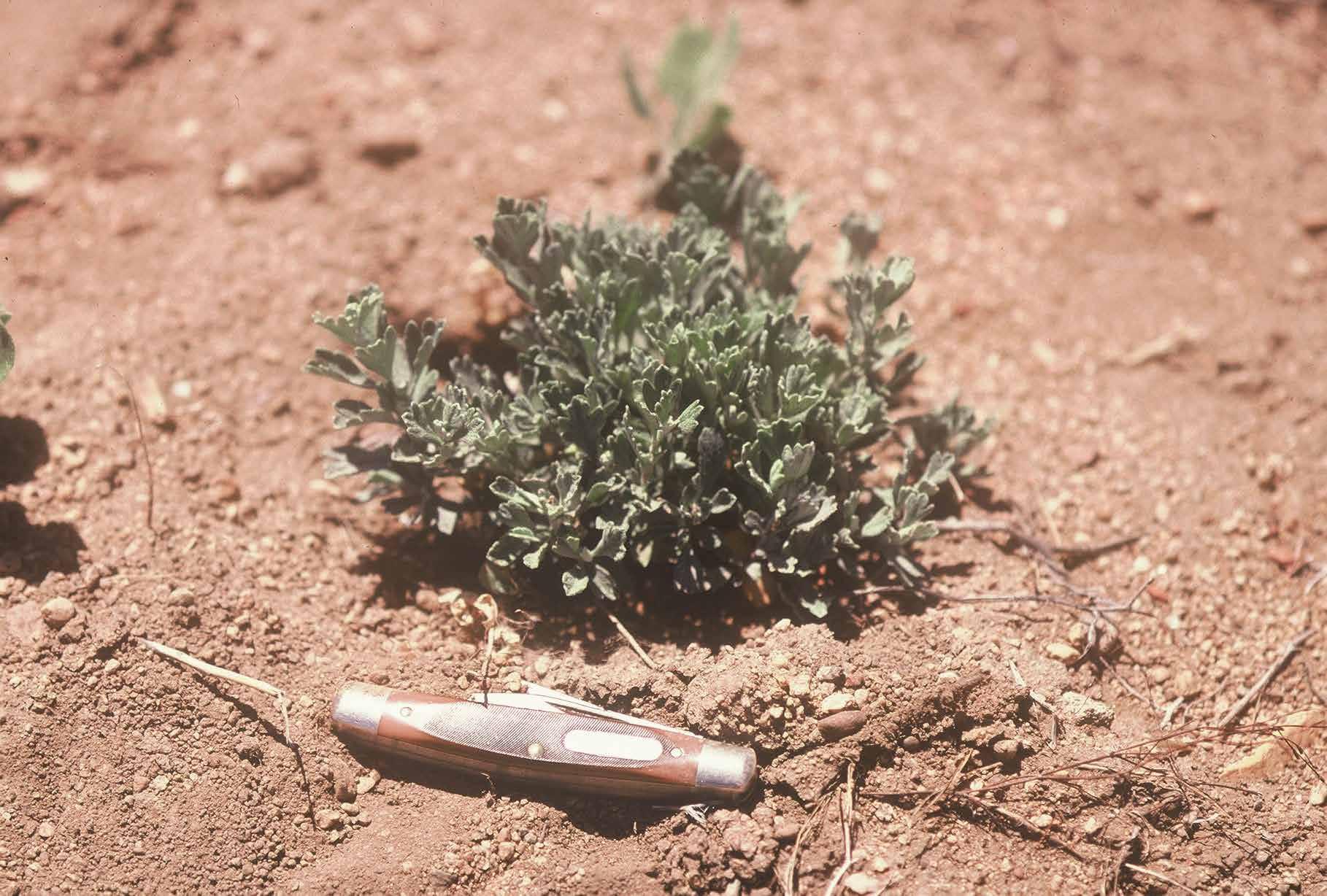
Figure 3 (above) Scatter hoard caching behavior by granivorous rodents, such as kangaroo rats, are the key mechanism for seed dispersal and recruitment of antelope bitterbrush.
Figure 4 (below) Antelope bitterbrush is a critical browse species to both native ungulates, especially mule deer, and domestic livestock as it provides much needed digestible protein during late summer, fall and winter months.
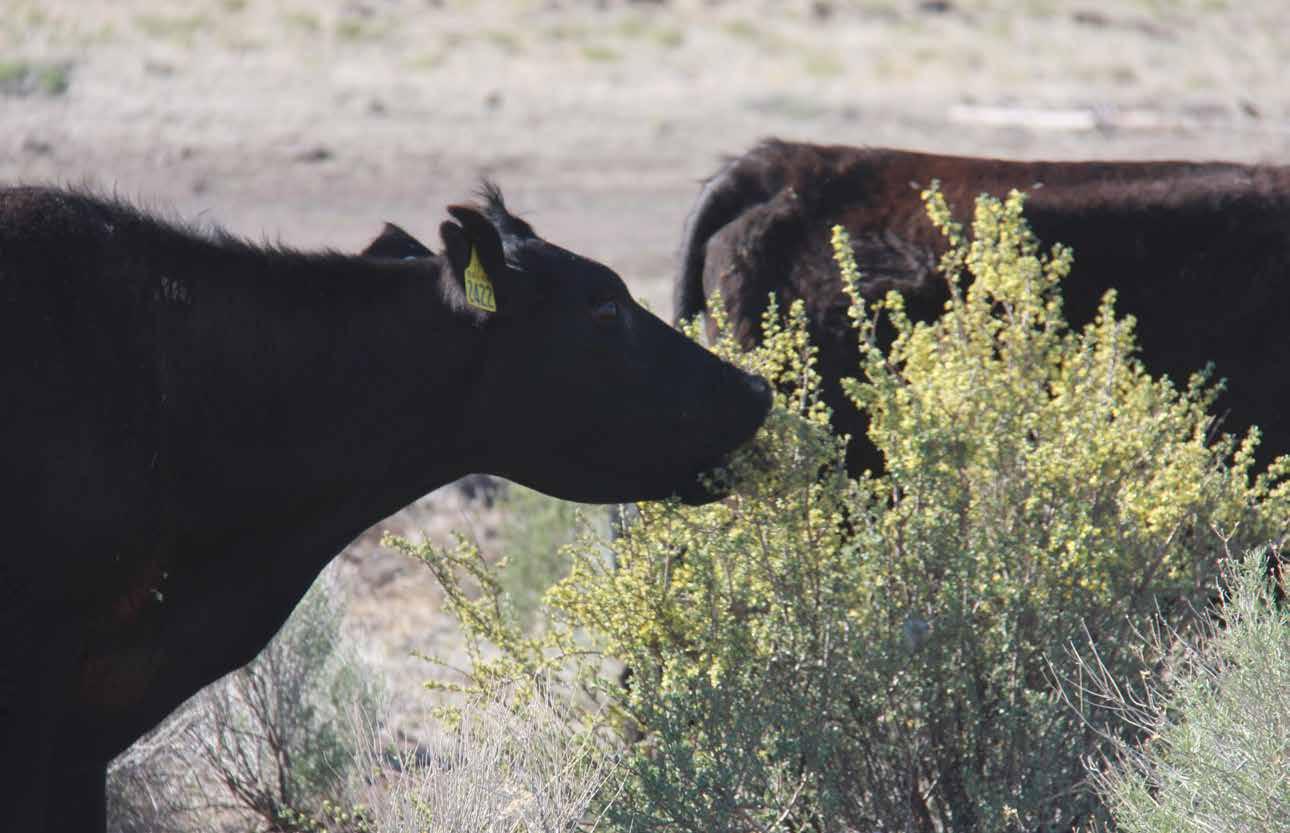
Graze Yearlings1500 on a 130 Acre Pivot for 30 Days

28 Ton Silage Pasco, WA
3.5 lbs. of Gain Per Day (69% TDN) 5-7 wt. Cattle*
* Jesse Norcutt, Currant, NV
Greenway Seeds Grazing Corn (GX80) is the No. 1 grazing corn in the nation because it is 5-6 days earlier than the competition. This allows the rancher to plant 5-6 days later and still reach peak sugar content (pre tassel) before the frost shuts you down!
Plant with a grain drill following second cutting on an older field alfalfa. Ready to graze in early September.
“We planted GX80 following second cut alfalfa. If we had to do that over we would follow third cut. We grazed 400 head for two weeks on 20 acres” Cory Veterre - Greenriver, Utah
Casey Calvin - Monte Vista, CO
We grazed lambs on GX80. They ate it all the way to the ground. Unbelievable! (See website for photos)
Crawford Cattle - Winnemucca, NV
Planted mid July, it was way over our heads. We were surprised as to how long we were able to graze. We also baled some of it. We’re buying again.
Cory Miller - Grass Valley Farm, Missoula, MT
We planted our GX80 under wheel lines and watered heavily. This was key as the corn grew 7ft tall!
Tom Kerns for Mike Becker Ranch - Baker, OR
We were able to carry 14 A.U.M.’s per acre with our late season grazing of GX80.
Jesse Norcutt - Currant, NV
We cut and baled the GX80 at pre-tussel. It was fed to 5-7 wt. cattle, and they gained 31/2 lbs/day
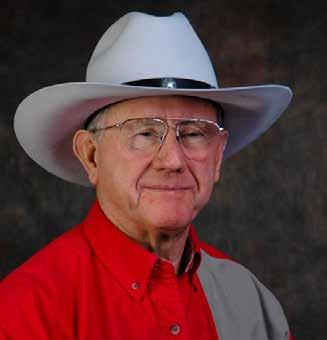
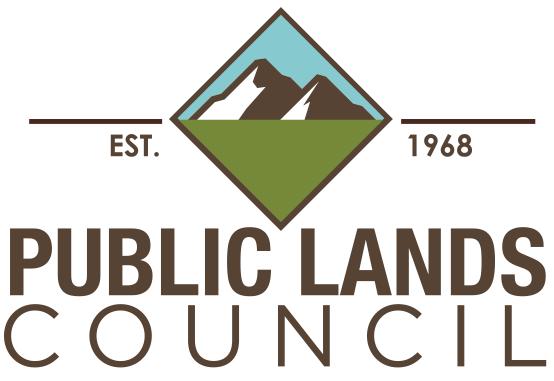
An analysis of western ranching politics.
Administration: Interior nominee faced questions over cuts and land sales in confirmation hearing.
Democrats hit Interior nominee on cuts, land sales, E&E News- Kate MacGregor, nominee for deputy secretary, testified Wednesday before the Senate Energy and Natural Resources Committee. Kate MacGregor parried questions Wednesday on understaffed national parks and selling federal lands in a public vetting of her nomination to be deputy Interior secretary. MacGregor, an energy executive and alum of the first Trump administration, would be reprising her role as second in command at the sprawling public lands and energy department. She sailed through the Senate Energy and Natural Resources Committee confirmation hearing Wednesday, mostly evading any head-on collisions with Democrats even as they pressed her on the administration’s contentious cuts and potential interest in offering public lands for sale.
Congress: Conversations continue as GOP discusses selling public lands; Daughter of late Rep. Grijalva announces bid for AZ House seat.
Fireworks follow GOP talk about selling public land, E&E News- Republicans have discussed the sale of some lands to help pay for their budget reconciliation package. Top Democrats and public lands advocates were aghast Wednesday over the news that Republicans have been discussing selling federal lands to help pay for their bill to advance President Donald Trump’s agenda. The discussions, reported by POLITICO’s E&E News, come as the GOP is hunting for ways to pay for their reconciliation bill, which seeks to boost energy production, cut taxes and provide additional support to the southern border. The bill will likely carry a multitrillion-dollar price tag, meaning Republicans need to find offsets for the cost. Republicans said that talks were still tentative and may only involve small parcels around National Parks or Western cities. The chair of the House Natural Resources Committee, Bruce Westerman (R-Ark.), described it as a “rounding error.” The U.S.
owns and controls about 640 acres of land — roughly 30 percent of the country — leading to frequent turf wars among the government, states and industry. But public ownership also ensures public access, a top priority for outdoor recreationists, hunters, anglers and conservationists.
Adelita Grijalva announces bid for late father’s House seat in Arizona, Roll Call- Arizona Democrat Adelita Grijalva, the daughter of Rep. Raúl M. Grijalva, said Monday that she will run for the Tucson-area seat vacated by her father’s death earlier this month. A Pima County supervisor, Grijalva cited standing up to President Donald Trump as a prime reason for her entering the special election for Arizona’s 7th District. Grijalva joins a crowded July 15 Democratic primary for the safely blue seat that already includes former state Rep. Daniel Hernandez Jr. The general election is scheduled for Sept. 23. If she wins, Grijalva would be the first Latina elected to Congress from Arizona. Two high-profile potential candidates have already taken their names out of the running for the special election: Secretary of State Adrian Fontes and Tucson Mayor Regina Romero, who is chairing Grijalva’s campaign, according to the candidate’s Monday announcement.
Grazing: New conservation deal pays grazing fees to allow elk crossing on Colorado ranch.
First-of-its-kind deal protects elk migration through private Colorado ranch, Colorado Sun- Park County rancher passionate about helping wildlife just signed a first-of-its-kind agreement with a conservation organization that will cover a significant portion of his cattle grazing fees in exchange for letting thousands of elk migrate through his property. And the Colorado Cattlemen’s Agricultural Land Trust, which helped broker the deal, says other ranchers are already asking how they can get in on it. Brendan Boeppel, conservation director at the land trust, said the organization has protected 800,000 acres of ranch land through conservation easements across Colorado since 1995, and that it’s exploring new ways ranchers can implement smart stewardship on their land without the “in perpetuity” condition of a traditional easement. Every winter Gottenborg lays down barbedwire fencing on his ranch so migrating elk won’t get hung up in it. He assists them out of the fullness of his heart — and his bank account — because the elk trample ground his cattle graze on during the summer and inadvertently wreck fences he seems always to be fixing. Now he’ll keep helping those elk while also saving a few bucks he normally pays other private landowners to let his cattle graze on their property.
Wolves: Catron County, NM voices concerns over increasing Mexican wolf populations. Catron County could declare state of emergency over Mexican wolf population, KRQE News- Pets snatched from front yards and livestock killed. That’s what Catron County said is happening because of what
they believe is too many Mexican wolves in their area. Now, county commissioners plan on declaring a state of emergency to protect animals and the public. “Catron County is saturated with wolves,” said Catron County Commissioner Audrey McQueen. Catron County said there has been an increase in Mexican wolf activity. They’re worried with the amount of sightings across the county and reports of livestock being killed. “Parents don’t even let their kids go out to play anymore without supervision. You can’t even let your dogs out of the house to just roam free,” said Commissioner McQueen. McQueen, who is also a rancher, said that just recently she lost four cows and one calf to wolves. She said the county has a high population of Mexican wolves, which the government has been working to recover since the late 1990s. Since then, McQueen said the wolf population is only growing in her area. According to the county, the wolves aren’t frightened by humans and are hanging out near people, with some sightings near schools. When wolves kill livestock, officials said it costs the county a lot of money every year, even though there is a federal program meant to reimburse ranchers for livestock killed by wolves.
Industry: NCBA Senior Vice President of Government Affairs, Ethan Lane, weighs in on President Trump’s reciprocal tariff plan.
Executives, trade and labour associations on Trump’s reciprocal tariffs, MSN- President Donald Trump said on Wednesday he would impose a 10% baseline tariff on all imports to the United States and higher duties on some of the country’s biggest trading partners, a move that could escalate a trade war and upend the global economy. Trading partners are expected to respond with countermeasures that could lead to dramatically higher prices for everything from bicycles to wine. Ethan Lane, Senior VP of Government Affairs, National Cattlemen’s Beef Association noted, “President Trump is taking action to address numerous trade barriers that prevent consumers overseas from enjoying high-quality, wholesome American beef. NCBA will continue engaging with the White House to ensure fair treatment for America’s cattle producers around the world and optimize opportunities for exports abroad.”
Wildfire: PLC Executive Director, Kaitlynn Glover, urges Congress to back grazing for wildfire prevention.
Producers Urge Congress for Grazing Policy to Help Prevent Wildfires, Drovers- Wildfires have been in the news recently with many West and Midwest states burning acres in 2025. Texas had the second largest fire in history a year ago, burning 1,058,482 acres. The West also had an extreme fire year in 2024 with four states burning at or close to a million acres in each, including California, Idaho and Wyoming. Oregon set a record of burning 1.9 million acres. Kaitlynn Glover is the Executive Director of the Public Lands
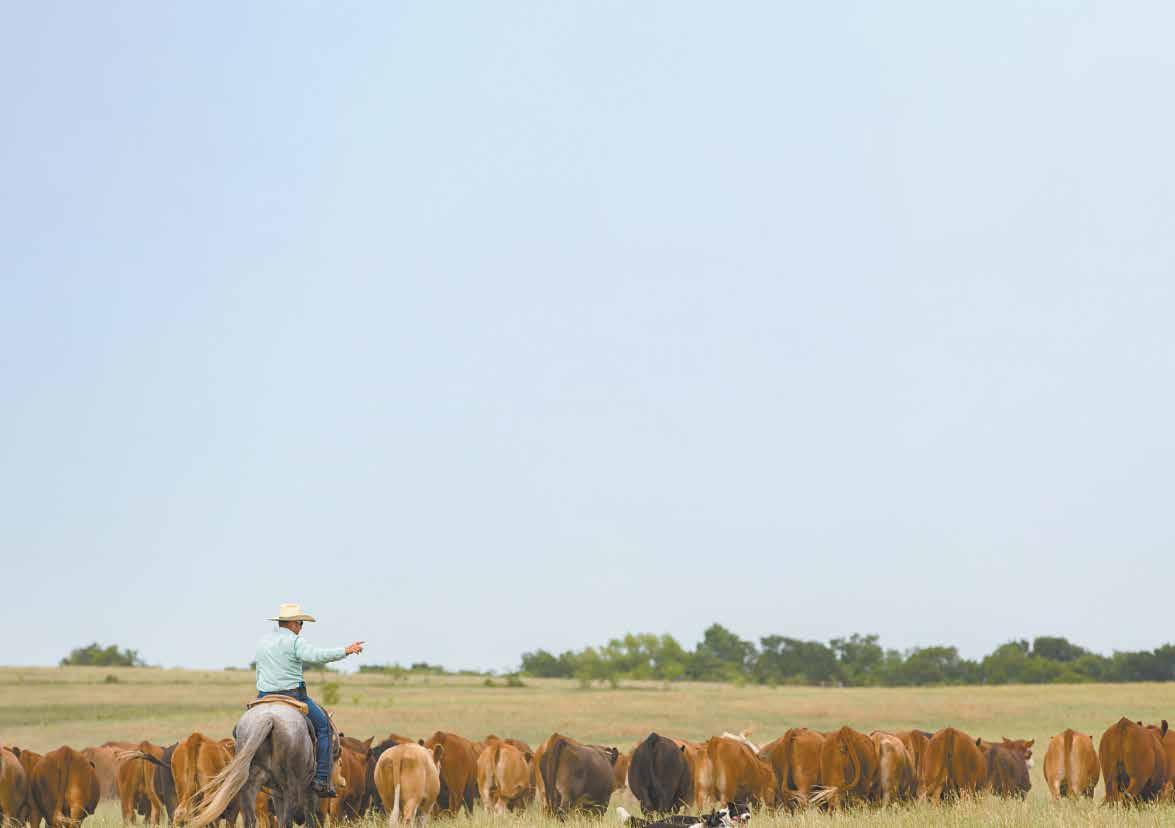
Council (PLC) and works on natural resources for the National Cattleman’s Beef Association (NCBA). She spoke about wildfires and the importance of commonsense grazing policy as a wildfire prevention tool with guest host Michelle Rook on AgriTalk. “I feel like no matter any time in the year, no matter which year we’re talking about, there’s always going to be an anniversary of a big fire in the West,” Glover says. “The fire in Texas was absolutely devastating, and we’ve seen fires since then in California and Idaho and Washington and in these western states, and even in these Midwestern states, where you have a lot of grazing, you have a lot of forage build up, these grasses that dry out, especially if it’s dry later in the year. Grazing really is the best tool to be able to remove that risk from the landscape.”
hearing for Interior
Deputy Secretary nominee, Kate MacGregor, set for today.
Kate MacGregor’s second act, E&E News- The former Hill staffer and Interior deputy secretary faces a confirmation hearing Wednesday to return to the department. Kate MacGregor is a utilities executive, Interior Department alum and veteran rower who has already crewed for Team Trump. Interior’s deputy secretary for part of President Donald Trump’s first term, MacGregor is now poised to take the second seat again. Her confirmation hearing Wednesday before a Senate panel is likely to showcase her comfort on Capitol Hill, her inside knowledge of the department and her commitment to Trump’s agenda. If confirmed as Interior Secretary Doug Burgum’s deputy, as appears all but certain, MacGregor will be in a position often described as the day-to-day manager of the department that started the year with about 70,000 employees and an annual budget of roughly $18 billion.
House halts floor activity after proxy voting spat, E&E News- Nine House Republicans voted with Democrats on Tuesday to reject Speaker Mike Johnson’s bid to block a GOP member from allowing lawmakers who are new parents to vote by proxy. House Republican leaders inserted language into a procedural measure that would effectively kill Rep. Anna Paulina Luna’s proxy-voting proposal, which was due to come to the floor later this week. Luna had circumvented party leaders by successfully pursuing a discharge petition. That measure failed on a 222-206 vote. Joining Luna were GOP Reps. Tim Burchett of Tennessee, Kevin Kiley of California, Nick LaLota of New York, Mike Lawler of New York, Ryan Mackenzie of Pennsylvania, Max Miller of Ohio, Greg Steube of Florida and Jeff Van Drew of New Jersey. Approving the “rule,” as the measure is known, would have tabled the discharge petition and blocked future similar proposals, leading Luna and other Republicans to line up against it. Luna and 11 other House Republicans signed onto the discharge petition to force consideration of the proxyvoting measure.
Senator seeks end to Forest Service aircraft inspections, E&E News- Montana Republican Tim Sheehy’s aviation company built its business fighting wildfires for the federal government. A generation ago, a spate of fatal crashes of planes and helicopters the Forest Service hired to fight wildfires spurred the agency to start having its own inspectors to make sure the aircraft could safely fly. Now a senator tied to that industry says the inspections aren’t necessary and that the Forest Service should halt them. Republican Tim Sheehy, the founder of a Montana-based company that’s made millions of dollars in Forest Service firefighting contracts, said the agency’s inspections are outdated and duplicate the Federal Aviation Administration’s oversight responsibilities. Indeed, he once requested a review of a fatal 2021 air crash in which the Forest Service failed to detect a crack in an aircraft’s wing.
Republicans weigh sales of public land in reconciliation, E&E News- Republicans are mulling the sale of some public lands to help pay for a massive budget reconciliation bill to advance President Donald Trump’s agenda. But just how big they’ll be able to go is an open question. The discussion, according to lawmakers interviewed by POLITICO’s E&E News, is still in the early stages and is far from guaranteed to make it into a final package. According to one top Republican, concepts under discussion include the sale of some lands around Western cities or national parks to build more housing. Still, the land sales could ignite a firestorm of opposition from Democrats and public land advocacy groups, and deepen fissures within the Republican Party. With Republicans needing offsets for extending the 2017 tax cuts and other spending, the idea of selling government land has stayed on the agenda, along with more oil and gas leases.
Judge rules against USFS over grizzly bear protection in Paradise Valley.
Federal Magistrate Rules for Environmentalist, Finds the Forest Service Failed to Protect Grizzly Bears From Expanded Cattle Grazing, CounterPunch- Montana’s Paradise Valley is aptly named. Sitting between two towering mountain ranges, it cradles the mighty Yellowstone River that flows from its headwaters in America’s first national park and provides critical habitat to the native species still present 200 years after Lewis and Clark’s expedition, including grizzly bears, wolves, and wolverines. Yet, the Forest Service decided to expand cattle grazing on six federal allotments on the valley’s east side, including in grizzly bear recovery zones, It is a formula for destruction of native vegetation, sedimentation in cutthroat spawning streams, and dead wolves and bears – which is why United States Magistrate Judge Kathleen DeSoto issued her Findings and Recommendation Order in favor of the Alliance, Native Ecosystems Council, Western Watersheds Project, and six other wildlife and ecosystem protection advocacy groups on March 27th. The Court ruled in our favor on four out of five of our National Environmental Policy Act claims including: (1) failure to analyze the effects of putting cattle on the allotments early in the spring; (2) failure
to analyze habitat connectivity, which is an important factor for grizzlies; (3) failure to analyze the cumulative effects related to activities on private lands in the area; and (4) failure to prepare an Environmental Impact Statement.
Feds plan to remove wild horses from 2.1 million acres of WY land in July. Feds plan to remove all wild horses from 2.1M acres of Wyoming’s ‘checkerboard’ starting in July, WyoFileBLMs contentious plans to remove all free-roaming horses from vast reaches of southwest Wyoming’s “checkerboard” region could begin as soon as this summer, although a legal appeal to stop roundups remains in limbo. On Monday, the federal agency released a 47-page environmental assessment outlining plans to gather and permanently remove several thousand wild horses from 2,105 square miles — an area nearly the size of Delaware — managed by BLM’s Rock Springs and Rawlins field offices. Horses would come off an additional 1,124 square miles of private land within the checkerboard. A public review period is underway with comments due by April 30. If the BLM greenlights the round-ups, they could begin within the next three months and continue for a couple of years, possibly longer. First to go would be the estimated 1,125 free-roaming horses in the Salt Wells Creek herd and 736 animals in the northwestern portion of Adobe Town, according to BLM Rock Springs Field Office Manager Kimberlee Foster. Then in 2026, horse-removal crews would move on to eliminating an estimated 894 horses in the Great Divide Basin herd.
project.
Lithium project in southeastern Oregon gets public input extension, OPB- Federal officials have extended what was initially a days-long public comment period for a lithium exploration project in southeastern Oregon. Australia-based Jindalee Resources’ proposal includes drilling at more than 260 sites across 7,200 acres of sagebrush desert in Malheur County, near the Oregon-Nevada border, in search of lithium. The highly valued metal is a key ingredient in batteries, including those that store renewable energy and power electric vehicles. The region’s famed McDermitt Caldera — formed by an ancient supervolcano — is thought to have some of the highest concentrations of lithium in the United States. Nevada already has paved the way for what’s expected to be the largest lithium mine in North America. Jindalee’s proposal is the first step to building one on the Oregon side of the caldera. The U.S. Bureau of Land Management has been reviewing Jindalee’s proposal to explore federal land for lithium since 2022. The agency published its resulting environmental assessment last week, and gave the public just five days to review and comment on hundreds of pages of analyses and data.
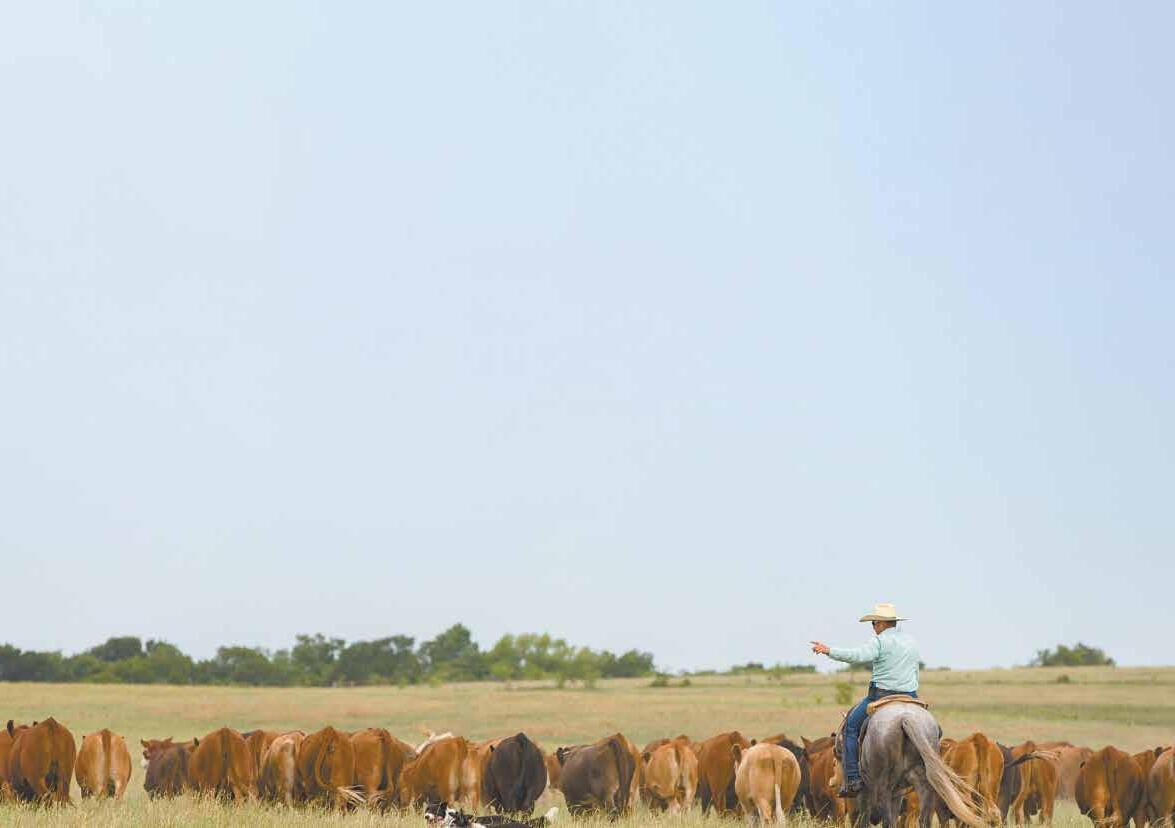

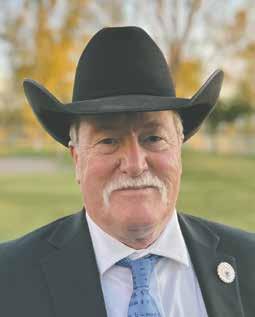
March has come and gone, and spring is finally starting to show itself across the West. Calving season is in full swing, and we’re all spending long days making sure the next generation of our herds gets off to a strong start. At the same time, PLC has been hard at
work in Washington, D.C., ensuring that our voices are heard where it matters most.
At the legislative level, there is a growing push to reform the ESA. PLC Secretary Robbie LeValley testified before the House Subcommittee on Oversight and Investigations about the unnecessary burdens placed on livestock producers by the U.S. Fish and Wildlife Service’s misuse of the 10(j) rule to introduce experimental populations. This testimony highlighted the real-world consequences of these policies and reinforced the need for meaningful reform.
Shortly after, Chairman Westerman introduced the ESA Amendments Act, a bill aimed at modernizing the law to focus on species recovery rather than permanent listings and unnecessary land-use restrictions. These are important steps PLC is taking to advocate and protect the rights of ranchers across the West. Now more than ever, it is critical that we get our story out there. Some of our critics continue to push the false idea that land management is an “either-or” decision—either you have wildlife, or you have grazing. We know the truth: wildlife thrives on well-managed landscapes, and ranchers are key partners in conservation. We need to make sure policymakers understand that. A great way to do that is by participating in PLC’s 2025 Legislative Conference. This event provides producers with the opportunity to meet with members of Congress and relevant agencies to discuss important topics affecting us ranchers across the West.
At the executive level, as we move forward under a new administration, there will be challenges, but also opportunities. Every presidency comes with changes in leadership, priorities, and policies, and while we may not always agree with every decision, it is critical that we engage in these important discussions and give the leadership a chance.
There is a lot of work to do, but I am confident in the strength and resilience of this industry.
I look forward to seeing many of you in D.C. next week.
Tim Canterbury, President, Public Lands Council

Over the past 4 weeks, the pace in Washington has continued to build. Narrowly avoiding a government shutdown mid-month, Congress passed a Continuing Resolution to fund the government through the end of the fiscal year. PLC was able to continue to protect crucial legacy provisions like a prohibition on a Greater
Sage-Grouse listing and prohibitions on greenhouse gas reporting requirements, as well as continued funding for important programs like Wildlife Service predator control efforts and Wild Horse and Burro program funding.
Tim and Garrett have highlighted the depth of focus we’ve had on ESA this month, and I don’t expect the momentum to wane anytime soon. Progress on ESA reform will continue alongside permitting reform efforts, Senate attention on the Fix Our Forests Act, and the march to confirm key leadership across federal agencies.
Over the next month, we expect to see the Senate Committees move forward on the nominations for BLM and USFWS directors, as well as a host of USDA undersecretaries who will oversee grazing, conservation, forestry, and market program activities.
I’m excited to welcome public lands ranchers from our 14 western affiliates next month for our Legislative Conference where leadership will focus on policy initiatives like grazing regulations reform, our work to expand grazing as a land management tool, and building agency capacity to support range management.
This last month has not been without its challenges; PLC continues to work with political leadership to ensure efforts to streamline regulations and improve government efficiency don’t render grazing and land management programs inoperable. We support all efforts to reduce regulatory burdens and simplify federal operations, and are fully engaged to bring the best ideas to the top.
Congratulations to our partners at ASI on their successful legislative fly-in this month. Our partnership with sheep producers continues to be a hallmark of our long, successful history, and it’s not hard to see why. The latest numbers from NASS show the sheep industry continues to diversify and increase. We look forward to seeing you next month in Washington for our Conference.
Kaitlynn Glover | kglover@beef.org Executive Director, Public Lands Council
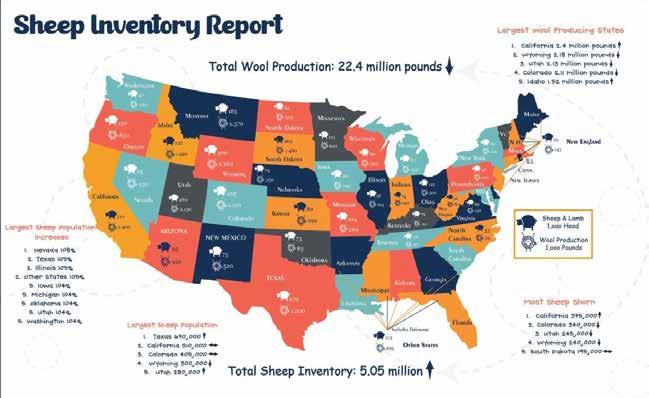

March is coming to a close, but springtime is in full swing here in DC. PLC has been boots to the ground this month, and Washington is moving faster than ever.
We are about a week out from our 2025 Legislative Conference here in the nation’s capital, and we hope that you will be joining us. It will be a full few days of discussion,
hearing what this new Congress and Administration has planned and is planning for the next few years. I encourage you all to attend, engage, and learn as we embark on this year’s efforts. As you will read on throughout this newsletter, you will find more information on what our Legislative Conference will entail, along with our 2025 Nick Theos Scholars. We are excited and eager to have the next generation attending and learning more about the work PLC does!
Additionally, we are excited to announce this year’s Annual Meeting, which will take place in Flagstaff, Arizona. So, mark your calendars and saddle up as we prepare to head to the Grand Canyon State in September! More information will be available in the coming weeks. As always, it is a pleasure to serve this industry and I look forward to seeing many of you next week here in Washington, DC.
Will Baugh | wbaugh@beef.org
Associate Director, Public Lands Council

PLC is excited to announce that our 2025 Annual Meeting will be September 16-18, 2025, in Flagstaff, Arizona! As we look ahead to the fall, we are excited to be heading to the Grand Canyon state, land of saguaro cacti, turquoise, and bola ties! Our annual meeting will be held at the DoubleTree by Hilton Hotel Flagstaff. Saddle up and get ready for a fun week in Arizona! We will have a robust lineup of activities, speakers, and events this year, and you won’t want to miss out! More information will be released in the following weeks, including registration and hotel details, as well as tentative scheduling. We look forward to seeing you in Flagstaff!

With the cherry blossoms in peak bloom, the Endangered Species Act (ESA) is also having its peak activity season on Capitol Hill. Conversations about species management, land use, and regulatory reform are in full swing, with no shortage of legislation that could impact public lands ranchers.
One of the biggest developments this month was the nomination hearing of Brian Nesvik to lead the U.S. Fish and Wildlife Service. A key takeaway from his nomination process was how smoothly he sailed through the Senate Environment and Public Works Committee hearing. Democrats received his nomination well, and we could see a bipartisan confirmation vote. Having worked alongside ranchers as Wyoming’s Game and Fish Director, Nesvik understands the realities of managing wildlife in balance with working lands. We were proud to submit a letter of support because, at the end of the day, we need decisionmakers who recognize that real conservation happens through collaboration—not top-down mandates.
This month, ranchers were on the Hill testifying on the ESA’s 10(j) rule, ensuring lawmakers heard directly from those living with the consequences of species reintroductions. When it comes to managing apex predators like wolves and grizzly bears, the people who work the land every day must have a voice in the process. PLC’s own Robbie LeValley made it clear that regulatory overreach and litigation abuse cannot continue to drive these decisions. With ranchers leading the charge in these discussions, we also saw movement on critical ESA legislation.
The ESA Amendments Act of 2025 (H.R. 1897) would cut red tape, put states in charge of recovery strategies, and prevent endless litigation from derailing delisting efforts. Likewise, the Pet and Livestock Protection Act (H.R. 845) would finally remove the gray wolf from the Endangered Species List—something that should have happened long ago. Meanwhile, the Fix Our Forests Act (H.R. 471) saw movement in the Senate. These bills share a common goal: cutting bureaucratic roadblocks and enabling real, effective management of our lands and wildlife. We’ve made it clear to lawmakers that ranchers don’t just support these reforms—we need them.
And, of course, Congress once again kicked the government funding can down the road, with a continuing resolution now pushing the deadline to September 30. While that avoids a shutdown for now, the real work is just beginning as lawmakers gear up for budget reconciliation. There’s plenty of speculation about how things will shake out, but one thing is certain—this process could have real implications for rural America, and we’ll be keeping a close eye on it.
As we wrap up March, don’t think for a second that things are slowing down. Budget battles are heating up, and the months ahead will be critical. We’ll be here every step of the way, making sure ranchers’ voices are heard. Stay tuned.
Garrett Edmonds | gedmonds@beef.org Director, Public Lands Council
PLC is proud to announce its 2025 Nick Theos Scholars, Madison Orem and Nicki Nimlos. The Nick Theos Scholarship Program was established by the Theos family to ensure that young professionals are able to attend the PLC Legislative Conference in Washington, DC each year, allowing them to learn about current legislative issues surrounding the public lands ranching industry in our nation’s capital. Please join us in congratulating Madison and Nicki and read more about them below!

Madison Orem is from the rural community of Heppner in north-eastern Oregon. She grew up on her family’s first-generation wheat, hay, and cattle ranch where she grew a passion for the agriculture industry. After graduating from Ione High School, she is continuing her education at the University of Idaho. Currently she is in her sophomore year, majoring in Animal Science PreVet and Agricultural Economics. She is involved in the Student Idaho Cattle Association, Women in Business, Idaho Collegiate Young Farmers and Ranchers, and a member of the Kappa Alpha Theta Sorority.
The past month in The Sorting Pen has been in a whirlwind of public lands policy with a mix of serious work and a dash of fun. While keeping busy with ESArelated comment periods and Appropriations requests, we also took a break to perfect our grilling techniques— because when you’re not drafting public comments or tracking legislation, the next best thing is searing up a perfectly grilled tri-tip. We’re on the road to becoming certified grill masters, no doubt!
March also saw PLC Secretary Robbie LeValley testify before Congress, highlighting the importance of reducing the burdens caused by the Endangered Species Act. Robbie was a great representative of the interests of PLC and all the ranchers of the West it represents. It was a powerful moment for the organization and a reminder of why it’s crucial to have a strong presence on the Hill. Speaking of the Hill, Sam had the opportunity to join the NCBA Legislative Conference with the Oklahoma Cattlemen’s Association, and Madelyn attended with the North Dakota Stockmen’s Association. With these two groups, we were able to see ranchers personally advocating for important issues impacting not only their states but our industry as a whole. It was an exciting learning experience that highlighted the critical role important conversations and relationships with members of Congress and their staff play in shaping policy of the industry that is the livelihood of so many.
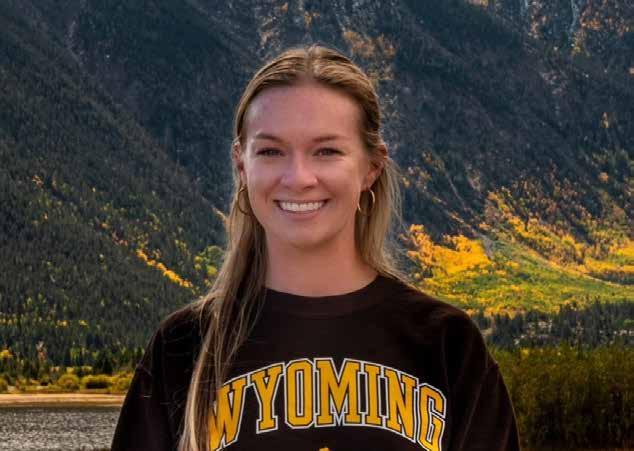
Nicki Nimlos is a fourth-generation Montanan. She received her B.S. in Biology from Boise State University, her M.S. in Forestry and Natural Resources from the University of Georgia and is currently pursuing a Ph.D. in Rangeland Ecology and Watershed Management at the University of Wyoming. Her research focuses on opportunities for ranchers in the carbon market, cattlewomen as resilient stewards of the land, and opposition of a methane tax on cattle. She currently serves as the collegiate member on the board of directors for the American National Cattlewomen and is also a member of the Wyoming and Colorado Cattlewomen.
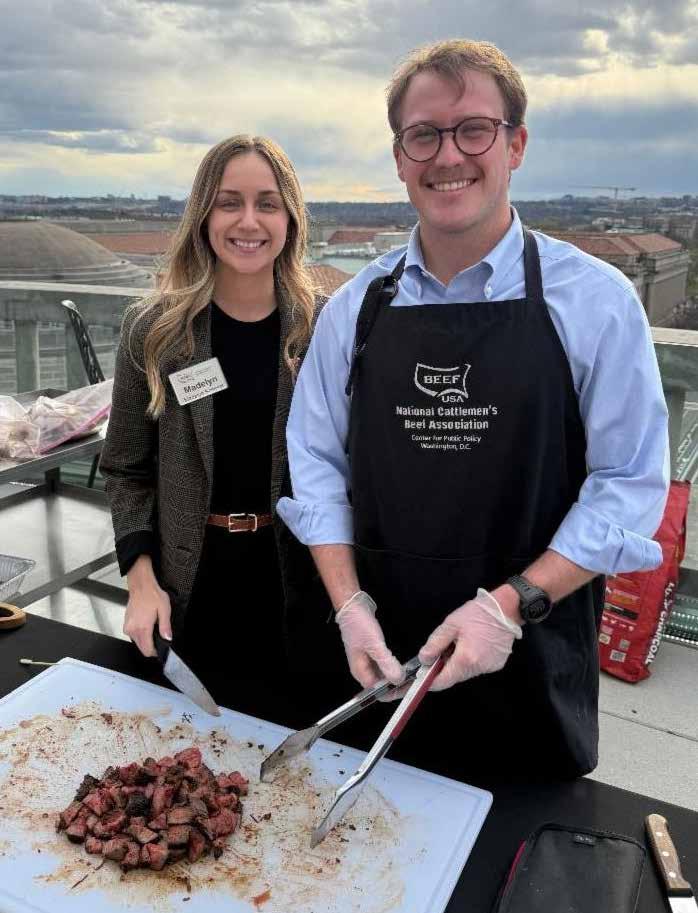
Between tracking legislation, navigating the complexities of ESA issues, and responding to public comment periods for a variety of species, it’s been a busy but productive month. We’re juggling it all—grilled tri-tip in hand!

Testimony on behalf of the Public Lands Council with regard to:
“Understanding the Consequences of Experimental Populations Under the Endangered Species Act” submitted to the House of Representatives Natural Resources Committee Subcommittee on Oversight and Investigations
Testimony of Robbie LeValley, Public Lands Council Secretary | Tuesday, March 4, 2025
Chairman Gosar, Ranking Member Dexter, and Members of the Subcommittee, thank you for the opportunity to provide testimony on “Understanding the Consequences of Experimental Populations Under the Endangered Species Act (ESA)”. My name is Robbie LeValley, and I serve as Secretary of the Public Lands Council (PLC). Since 1968, PLC has been the only organization in Washington, D.C., dedicated solely to representing the unique perspectives of cattle and sheep producers who hold the 22,000 federal grazing permits. On behalf of those thousands of permittees and landowners across the West, I appreciate the opportunity to provide testimony to this Subcommittee.
I am a fourth-generation rancher from Hotchkiss, Colorado, where my family and I run a cow-calf operation. LeValley Ranch is located in West Central Colorado and is a multi-generational business that manages private and federal land. We hold federal grazing permits on Bureau of Land Mangement (BLM) and U.S. Forest Service (USFS) lands. We have a strong partnership culture and have worked cooperatively with the U.S. Fish and Wildlife Service (USFWS) for decades as our private and public lands provide the habitat for one of the satellite populations of the Threatened Gunnison Sage Grouse. LeValley Ranch and countless other permittees across the West provide key habitat for grouse and other species, and when necessary, have modified grazing management plans to supplement agency actions for the benefit of the grouse.
Through our family operation and in our leadership roles across the industry, my family has been involved for decades in conversations about a host of species, including predators like wolves. In November 2020, the state of Colorado passed Proposition 114, which became state statute 33-2-105.8. Despite robust concern from ranchers and rural communities alike. The initiative directed the Colorado Parks and Wildlife Commission (CPW) to develop a plan to
introduce and manage gray wolves in Colorado west of the Continental Divide no later than December 31, 2023. In December 2023, CPW experts captured 10 gray wolves in Oregon. They released them onto public land in Summit and Grand counties with the goal of creating a permanent, self-sustaining wolf population in Colorado.
As part of this reintroduction process, CPW requested that the USFWS designate the population that would be reintroduced as an experimental nonessential population under section 10(j) of the ESA. The ESA prohibits the “take” of any listed species except as specifically allowed by the statute and accompanying regulations. By designating wolves in Colorado as a NEP with the 10(j), take of the species is authorized in a broader range of circumstances than otherwise allowed for an endangered species, including lethal take for depredating wolves. While the ballot initiative and subsequent introduction was not my preferred outcome, I appreciate the Colorado USFWS employees who diligently worked on the entire NEPA process to authorize the10(j) designation.
Gray wolves in much of the United States are listed under the federal ESA as endangered and in most places, there are very limited tools for ranchers like me, and our state agencies, to take action when conflict arises between these apex predators and everything else in the ecosystem.
As a listed species under the ESA, primary management authority over gray wolves’ rests with the FWS. FWS has delegated some of this authority to CPW to take the lead in carrying out the reintroduction in Colorado. This delegation, however, does not strip FWS of any of its authority to manage the species that it would otherwise have. Accordingly, under the current regulatory regime, it is possible, from a legal perspective, for FWS to assert its primary authority and impact wolf management. However, there is significant uncertainty regarding whether FWS would take meaningful action on wolf management. Although the agency has the legal authority to do so, even over the state’s objections, FWS may not be willing or able to have that fight. There is also no telling how long such helpful intervention would last.
While this list is not exhaustive, it compiles some of the direct hardships that producers like me and many others face due to the federal wolf policy.
1) Livestock Depredation – Wolves kill or severely injure cattle and sheep, leading to direct economic losses. Even if ranchers are compensated for confirmed kills, verifying wolf predation can be difficult. Carcasses are often scavenged before documentation, and stress-induced injuries or weight loss—both of which negatively impact herd health—are not compensated. Ranchers bear the financial burden of these losses, often with little recourse. At the end of the year, two
counties submitted a $582,000 depredation compensation claim to CPW. If all claims are approved, this would deplete the state’s compensation fund – and the state is preparing for a second round of introductions later this year. Costs and depredations will continue to grow exponentially.
2) Stress and Herd Disruption – The mere presence of wolves alters livestock behavior. Increased stress makes cattle skittish, causing weight loss, lower calving success, and stress-induced abortions. These biological responses directly impact the economic sustainability of ranching operations and highlight the unseen costs of predator management. A 2014 study in Montana found that for ranches that had experienced depredations by wolves, there was a statistically significant decrease in rate of gain: calves were 22 lbs lighter1 than calves from similar operations that did not experience depredation. This nondeath loss can be the difference between a producer operating on a gain or a loss. Additional studies suggest that the financial impacts of indirect effects from wolves likely exceed direct losses2, while producers are only compensated for direct losses of protected species.
3) Impact on Rural Communities – Ranching is the economic backbone of many rural communities.As wolf populations expand, ranchers face mounting losses that threaten the viability of family-run operations. The long-term sustainability of these rural economies depends on the ability of ranchers to operate without the constant risk of predation losses that federal regulations fail to address adequately. Additionally, managing NEPs imposes significant financial burdens on states, requiring resources for monitoring, mitigation, and compensation programs. For example, Colorado’s wolf reintroduction program has already led to millions in taxpayer-funded expenditures, like surveillance, management planning, and conflict resolution. While the voters who supported reintroduction of the species live primarily in eastern Colorado, those of us in the West bear the costs of introduction. These financial burdens extend beyond direct state funding—rural economies reliant on agriculture, outfitting, and tourism face increased losses and higher operational costs due to restrictions and predation impacts.
4) Uncertainty in Future Management – For too long, ranchers and many other industries have faced the pendulum swing of executive agency regulation. Federal wildlife policy has become unpredictable, where regulatory certainty is nonexistent. Under Section 10(j) of the ESA, the USFWS designated Colorado’s reintroduced wolves as a nonessential experimental population, providing some management flexibility. However, this status is subject to change based
on political shifts or legal challenges. Ranchers need regulatory certainty—not a revolving door of changing policies that disrupt our ability to plan for the future.
The presence of nonessential populations causes land and resource management to change. By introducing a new species, USFWS places regulatory burdens on the area that previously did not exist, changing the expectation for the landscape and multiple use. This often occurs with little regulatory certainty for longstanding economic and social uses of the landscape, including grazing, hunting, fishing, and wildlife tourism. Large predators introduced under 10(j) designations can reduce game populations or change their movement patterns, leading to lower hunting success and reduced revenue from hunting licenses—an essential funding source for state conservation programs. Additionally, federal land agencies must shift management priorities to accommodate predator populations, which can disrupt grazing allotments, restrict public access, and increase regulatory burdens on land users. These shifts often come without adequate stakeholder input, putting rural communities at a disadvantage when balancing conservation with economic stability.
Without a doubt, there are substantial unintended consequences and increased regulatory burdens as part of any ESA designation. Designations made under Section 10(j) are not immune from that regulatory burden, because of the transitory nature of the designation. In the best-case scenario, a successful 10(j) population will be expanded, and tools could be taken away to allow for the full weight of the ESA to be applied to “ramp up” the intensity of recovery efforts. In truth, this could happen whether a 10(j) shows promising improvement, or if the species struggles to take a foothold. In either case, the 10(j) is the foot in the door that allows the Service to introduce a new federal nexus and the accompanying regulatory burdens. While this approach makes sense on paper, this Committee is aware ESA has a long, ineffective history that makes clear that a more stringent ESA classification does not make it more likely that the species will recover.
As a federal lands grazing permittee, navigating compliance with federal regulations and looking for opportunities to improve the landscape is part of my baseline mentality. The introduction of the gray wolf in Colorado presents a direct threat to operations already navigating complex regulatory regimes. While the tools provided under the 10(j) have provided some flexibility, many tools to protect our cattle, children, and families comes too little, too late. Despite all of this, we’re still here. We’re here because we take pride in our work on the landscape and the active management to ensure it stays healthy and resilient. Weare always adapting to a changing landscape, including a dynamic regulatory landscape. While we do what we can to continue to
feed our nation, I offer some suggestions to members of this subcommittee regarding the Endangered Species Act.
Congress must take meaningful steps to modernize the ESA to ensure that conservation efforts do not come at the direct expense of those who work the land. The following policy solutions would help address the ongoing challenges ranchers face:
1) Regulatory Certainty – Stop Moving the Goalpost: The ESA was never intended to serve as a permanent regulatory tool—it was designed to recover species and then remove protections once recovery goals are met. While the 10(j) population in Colorado is a new population for the state, it will not be the tipping point for the lower 48’s species’ viability, yet populations across the country continue to be treated as though they will be the lynchpin that finally secures delisting. Congress must ensure that once a species has met recovery criteria, the Service takes action to delist the species in a timely and final manner.
2) Support Science, not Litigation, in Decisionmaking: The ESA must rely on transparent, peer-reviewed objective science in both listing and delisting decisions, and in decisions about critical habitat and recovery plans. Too often, recovery goals and status are based on outdated science, politically driven data selection, and poorly crafted court edicts that do not reflect scientific reality. Congress should bolster provisions in the ESA to support USFWS’s position in defending their listing, recovery, and delisting decisions from frivolous litigation.
3) Local and State-Led Management: States are best positioned to manage wildlife populations within their borders. States have robust state wildlife management plans, are responsible for managing all non-listed species within their borders and are best attuned to local dynamics. Federal oversight is simply unable to accurately account for regional ecological conditions, economic realities, and the direct needs of rural communities. Congress should bolster the requirements for USFWS to consult and work with states through the ESA process. This would move away from the Service’s tendency to promote single-species management that compromises all other entities on the landscape and would make recovery and post-delisting processes more durable.
4) Consider Economic Impacts in ESA Listings: The ESA currently prohibits economic impacts from being considered in listing decisions. This is an outdated and impractical approach. Wildlife policy should not be formulated in a vacuum— it must account for the people and industries it affects. Or, as I would say, wildlife doesn’t stop where the gate closes. The economic impact
analysis should be considered before listing decisions are finalized. Rural communities should not bear the costs of species protection without a seat at the table.
5) Incorporate Improved Management Tools for Ranchers and Rural Communities: Many of the more controversial species this Committee considers are large predators that evoke widespread public engagement. When species pose a physical risk to their operations and families, the Service should ensure ranchers and landowners must have access to the full range of predator management tools, including:
• The ability to immediately remove wolves attacking livestock without excessive permitting hurdles.
• Greater flexibility in deploying non-lethal deterrents such as guard animals, fencing, and the ability to repair infrastructure damaged by predators —without burdensome federal restrictions.
• Address compensation programs so the impacts aside from depredation are considered and producers don’t continue to carry the weight of these decisions.
The ESA must be reformed to reflect scientific integrity, regulatory certainty, and economic realities. Section 10(j) is a starting point and an area where we can begin to listen and learn from those on the ground who interact with these species routinely. Wolves have met recovery goals, yet their management remains dictated by political interests rather than biological science. Ranchers, who steward millions of acres of grazing land and contribute to conservation through active land management, are being sidelined in favor of a regulatory agenda that ignores the on-the-ground realities of predator coexistence.
Chairman Gosar, Ranking Member Dexter, and Members of the Subcommittee, I appreciate the opportunity to provide a review of the last several years and offer suggestions about how to build a stronger future for the coexistence of our operations and the wildlife on these lands. As a fourthgeneration rancher, the institutional knowledge of the lands we manage will continue to be invaluable to these Western landscapes, but we will only be successful if we can maintain a business model that supports our families and communities.
Thank you for the opportunity to testify.
1 Ramler, Joseph P., Mark Hebblewhite, Derek Kellenberg, and Carolyn Sime. 2014. “Crying Wolf? A Spatial Analysis of Wolf Location and Depredations on Calf Weight.” American Journal of Agricultural Economics 96(3): 631–656. Available at: https://doi.org/10.1093/ajae/ aat100.
2 Steele, Jordan R., Benjamin S. Rashford, Thomas K. Foulke, John A. Tanaka, and David T. Taylor. 2013. “Wolf (Canis lupis) Predation Impacts on Livestock Production: Direct Effects, Indirect Effects, and Implications for Compensation Ratios.” Rangeland Ecology and Management 66: 539–544. Available at: https://bit.ly/46Afz7a.




The Third Annual Western Water, Ag, & Environmental Conference is a little over two months away, June 19-20 at the Peppermill Resort Spa Casino in Reno, Nevada. We’re excited and proud to partner with our friends at the National Association of State Departments of Agriculture (NASDA) Foundation for this year’s program. The Western focuses on legal and policy issues directly relevant to the ag industry in the Western U.S. It’s designed for attorneys, students, and other ag professionals who work in the Western ag industry. Please take a moment to check out this year’s agenda by visiting:
https://nationalaglawcenter.org/western2025/
The two-day conference will be approved for continuing education credits, including ethics credits, through numerous legal and professional organizations. More information is available at our website. Be sure to check the conference page for upcoming updates and announcements, as well as NALC social media (LinkedIn, Facebook, and X) or through our twice-monthly newsletter, The Feed at nationalaglawcenter.org/category/the-feed/
Thank you very much for being a part of our Western conferences so far. Please don’t hesitate to reach out if we can help with this or any other matter. My email is hmpittm@uark.edu and direct line is (479) 575-7640. Reach out anytime!
Respectfully,

Harrison M. Pittman Director, National Agricultural Law Center


Happy Spring! Leanna Spratling represented NVCW at Cattle Con 2025 so I asked her to share (see below). Thank you, Leanna, for sharing your experience.
Until we meet again, I hope this issue finds you healthy, happy, and enjoying your spring cattle care, whether that is shipping, calving, branding, or all the above. We work hard to put beef on the table so take the time to enjoy some of the good moments.
Keri Pommerening
Keri Pommerening
NVCW President
I had the honor of representing Nevada at the American National Cattlewomen meetings during the 2025 National Cattlemen’s Convention in San Antonio Texas.
This year, we started the ANCW side of the convention with a tour on Saturday at The Briscoe Western Art Museum. We then went to Grafft 7A Ranch which is a ranch outside of San Antonio that has an agri-tourism business. Their main attraction is an intricate corn maze that has a different design every year. They discussed with us some of the problems that they are facing everything from extreme drought to their experience with a known terrorist visiting their property. The last stop on the tour was Primo Processing. This butcher business has implemented a barcode-like system to keep track of their meat to ensure that their customers receive the correct products. This business also has a focus on exotic game animals and has worked with everything from cattle to zebras.
Our Sunday started with an optional worship service, followed by opening remarks. Our first guest speaker of the day was NCBA president Mark Eisele, who told us about his travels and his optimism for the future of this industry. Our second guest speaker was Vice President of Government Affairs Ethan Lane. He gave us an update on what’s going on in DC. Overall NCBA is very optimistic about
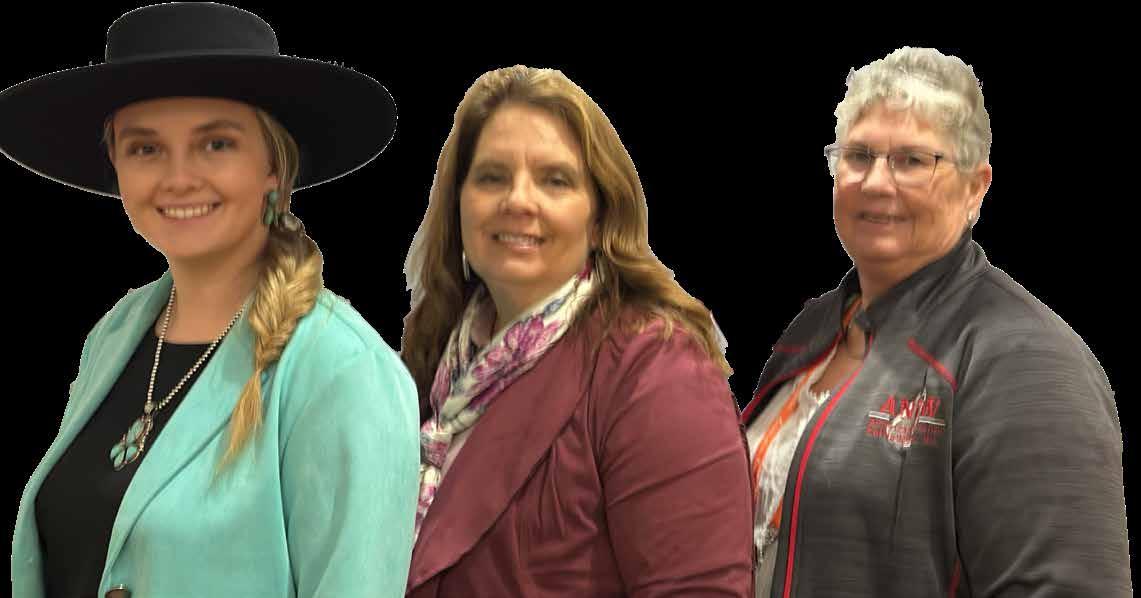
this administration and being able to work with them. Trump’s pick for Secretary of the Department of Agriculture is very open to and excited to work with NCBA. There are also a lot of opportunities for further and future tax cuts for the agriculture sector and to take back regulations from the previous administration including the Public Lands Rule.
These guest speakers were followed up with the States President’s Council where each state president or representative met in groups. We discussed different problems each state is facing and how different state organizations operate to share ideas and opportunities. After these discussions, we had two more guest speakers. One of them was Hailey Parton who did a presentation on “cattle trunks”. Cattle trunks are a way to organize and present various facts about the cattle industry. Everything needed for the presentation fits in a carry-on suitcase, so it can easily be exchanged and traveled with. The second presentation was working with state Beef ambassador programs training with Suzy Benny and Sara Shields. These two childhood friends have put together a renowned Beef Ambassador Program that trains students from elementary school to high school on how to be effective beef advocates. The day wrapped up with several committee meetings (as there are 13 committees within ANCW) an executive committee meeting and closing remarks.
Monday was the final day of the ANCW portion of Cattle Con, it included a Board Directors Meeting where I represented and voted on the behalf of Nevada CattleWomen, a general membership meeting and officer installation and lastly closing remarks. The New ANCW Officers include President Nikki Weston from our neighbor state Utah, President Elect Casey Matzke from Texas, and Vice President Debbie Chute from Minnesota.
We had a new fundraiser event this year called the Cowgirl Cotillion. This event took place Monday evening. It was a semi formal event that included a silent and live auction, an awards presentation, surf and turf dinner, and a live performance by Red Steagall. The event was a smashing success.
I highly recommend that anyone involved in the Cattle Industry attend Cattle Con. The learning and networking opportunities are unlike any other. Everything from classes to a HUGE trade show, live animal demonstrations, to industry meetings, and social events are offered at this convention. Not only is an amazing opportunity to get off the ranch and have a fun, but it is the best place to learn the latest and greatest happenings in the Cattle Industry.
Respectfully submitted, Leanna Spratling

The Central Nevada Regional Water Authority was established in 2005 to proactively address water issues in the Central Region, the largest of Nevada's 14 hydrographic regions. CNRWA formulates and presents a united position on water-related issues; monitors, assesses and responds to water projects that may adversely impact a member county; implements a groundwater monitoring program and encourages citizen participation in water-related issues. CNRWA’s nine member counties are: Churchill, Elko, Esmeralda, Eureka, Humboldt, Lander, Nye, Pershing, and White Pine.

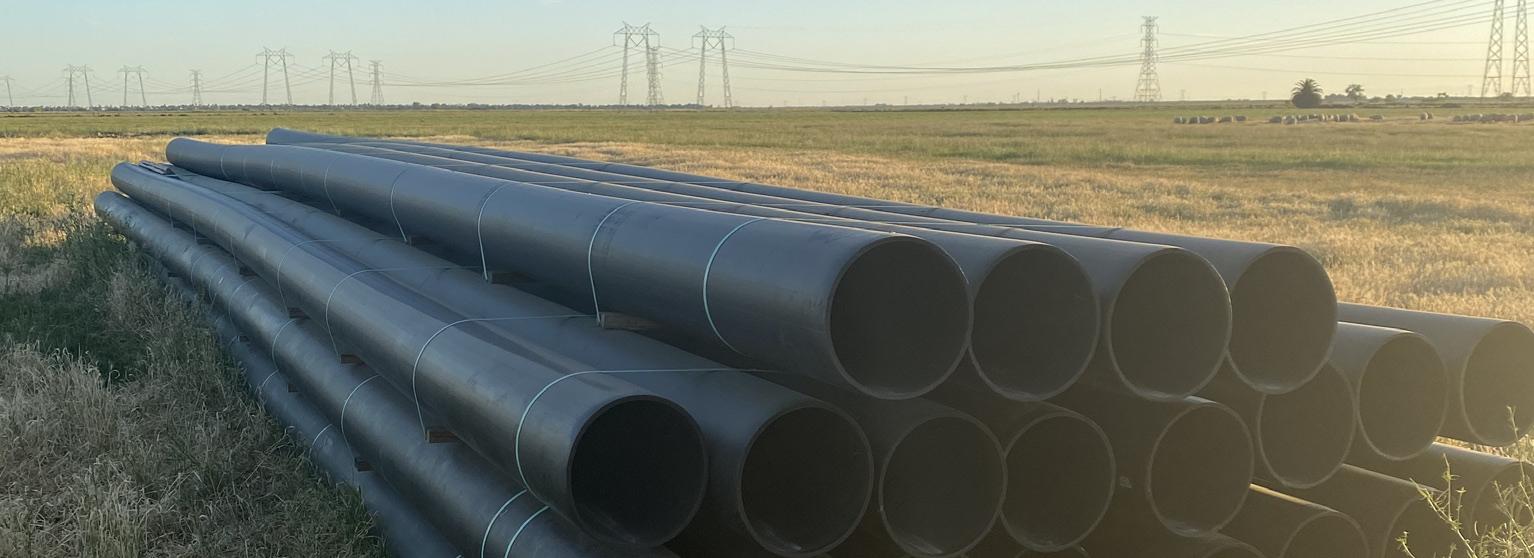

Riparian proper functioning condition (PFC) assessment uses common terms, definitions, and methods to identify opportunities for positive change from reasonable investments, enhance local management, and solve problems by people most affected. Integrated Riparian Management uses PFC assessment to prioritize needs for adaptive management with monitoring for riparian objectives and strategies. Trainings are available to landowners, Federal, State, and local agency personnel, tribes, industry, conservation interests, and others. Instructors are from Nevada Creeks and Communities Team. There is no cost for classes. Please share this announcement within your networks.
PFC Assessment for Integrated Riparian Management – February 17-19 by Zoom - The Zoom class will feature an optional evening (Wed.) of participant-provided practice or problem solving about class concepts.
PFC Assessment for Integrated Riparian and Grazing Management – May 19-23 McDermitt Community Hall, McDermitt NV.
PFC Assessment for Integrated Riparian and Grazing Management – June 23-27 Pioche, NV Fire Hall first building off Hwy 93 west on Airport Rd.
PFC Assessment for Integrated Riparian and Grazing Management – August 18-22, Eureka, NV Opera House
PFC Assessment for Integrated Riparian and Grazing Management – July 21-25 Feather River Land Trust Sierra Valley Preserve Nature Center 495 Beckwourth Calpine Rd., CA 96129
For PFC class reservations or questions: Sherman Swanson (775-233-6221 swanson@unr.edu) with name, affiliation, address, phone, e-mail, and interest, discipline, role or area of expertise.
You are welcome for the parts of the class you need or want (1 -5 days). After requesting a reservation, an agenda will provide a timeline. All classes begin mid-day on Monday with learning about and participating in PFC assessment, step 1 in the integrated riparian management process (IRMP). Presentations on steps 2 -7 of IRMP - riparian values, riparian area/reach prioritization, goals and objectives, management and/or restoration, monitoring, and adaptive management begin on Thursday for place based classes. PFC -IRMP and Grazing management classes include more about grazing management concepts and engagement with a case study for application of IRMP concepts.
PFC Assessment and/or Integrated Riparian Management -- Coaching field sessions are available for small groups such as interdisciplinary or collaborative teams beginning in May. Contact swanson@unr.edu
For reference materials go to https://www.blm.gov/learn/blm-library/agency -publications/technicalreferences Be sure to scroll down the page and expand the riparian area management section.


NRS 278.0228 states that every governing body must have a water resource plan by July 1, 2029 and it must be updated every 10 years.
A comprehensive plan that details the water resources of the county, the current and projected-future uses of this water, and implementable strategies to ensure water resources meet the needs of the community into the future.

278 Requirements of a Water Resource Plan:

Desert Research Institute (DRI) is working with Nevada Division of Water Resources to help counties achieve the goal of updating or developing a water resource plan by the end of 2026.
An interdisciplinary team of Desert Research Institute Scientists specializing in hydrologic sciences, data analysis and community engagement.
Technical expertise and guidance for plan development at no cost to the county.
Funds to support county involvement in plan development.
Coordination with Counties, NDWR & other Nevada Water Resource Planning Experts.


DRI will create an inventory of all surface water, groundwater, springs and associated water rights.
DRI will work with counties to write the county water resource plan.
Assess water resources for economic development opportunities.
Develop management responses for floods and droughts.
Protect valuable water resources by identifying and mitigating pollution sources.


•Existing Demand
Demand •If sources are sufficient quality and quantity
•Management strategies to ensure sufficient water to meet demands
DRI will analyze current demand and project future demand on water resources.
DRI will work with Counties to develop water resources management strategies.
DRI will develop a framework that guides counties in updating future WRPs.
Ensure long-term water supply through development of strategic management policies.
Balance community water needs to reduce conflicts.
Plan and support critical infrastructure upgrades.



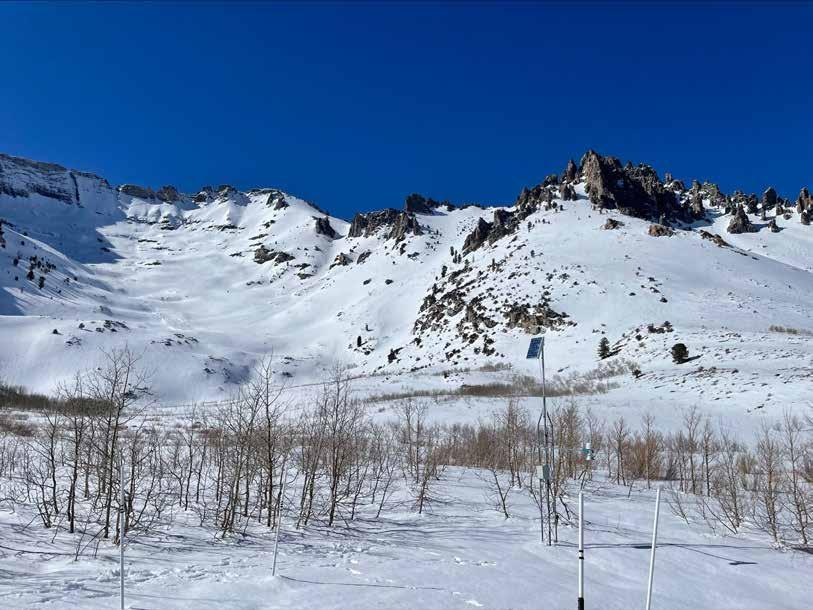
Full Report: www.nrcs.usda.gov/nevada/snow-survey
The last couple of winters have seen above normal snowpacks statewide, but this year we are seeing a range of conditions from above normal in the north to well below normal in the south. February brought above normal precipitation in most areas, boosting March 1 snowpacks above median in the Northern Great Basin, Humboldt, Owyhee, Snake and Clover Valley – Franklin basins. A few more storms in March will push each of these basins above their normal peak snow amounts by April 1. Snowpack conditions in the eastern Sierra are slightly less than normal and these basins will have to play catch up in March. Fortunately, Lake Tahoe is storing plenty of water to meet demands on the Truckee River this summer and Lake Tahoe is forecast to rise about another foot during snowmelt. The Truckee Canal has been flowing since early January to move water from the Truckee River to Lahontan Reservoir to supplement inflows from the Carson River. Lahontan Reservoir’s storage is above normal for this time of year. Reservoirs storage is also above normal in Stampede, Bridgeport, Topaz, Chimney Creek, Rye Patch, and Wildhorse reservoirs. The areas of greatest concern are Eastern Nevada and the Spring Mountains where snowpacks are 55% and 35% respectively. Across the state water year precipitation since October 1 ranges from 67% of median in the Spring Mountains, to 78% in Eastern Nevada, 8597% in the Sierra and 105-136% across the rest of northern Nevada. Streamflow forecasts across the region vary widely from south to north as well, from 56-204% when expressed as a percent of median due to the spread in conditions. Weather forecasts look promising for additional storms through the middle of March. Hopefully the storm track benefits the entire state, especially eastern and southern Nevada where drought conditions have worsened in recent months.
Thankfully, snowpack percentages have improved since February 1. Snowpacks are better in the north than in the south with basins across northern Nevada having above normal snow water amounts ranging from 107-148% of median. In the eastern Sierra, the Truckee basin is 92% of median while to the south, the Tahoe, Carson and Walker basins are 82-84%. Snow percentages are also better at higher elevations. Snow at lower elevation SNOTELs continues to be lacking due to rain instead of snowfall at these elevations during many of this season’s storms and some snowmelt during late February’s high pressure. This can be observed on the Interactive Map, note the red symbols which represent sites with snow less than 50% of median and some of these sites being snow-free. In the eastern Sierra and northern Nevada all the red symbols represent sites below 6,800 feet elevation. Increased solar input moving into March could make it difficult for snow-free areas to develop a persistent snowpack even with additional snowfall. The lack of lower elevation snow could impact on the volume of early season runoff.
Most of northern Nevada’s basins are only 1-2 inches of snow water away from reaching a normal peak snowpack. Snow percentages in the Tahoe, Truckee, Carson, and Walker basins returned to near normal in mid-February but dry weather during the second half of the month caused March 1 percentages to slip to 82-92% of normal. These basins will be playing catch-up in March with a couple more significant storms needed to achieve a normal peak snow water amount. It is becoming very unlikely Eastern Nevada and the Spring Mountains will reach a normal April 1 snowpack. March 1 snow percentages are 55% of median in Eastern Nevada and 35% in the Spring Mountains. On February 27, Great Basin National Park staff measured only 2 inches of snow depth and 0.6 inches of water content at Baker Creek #1 snow course which is located at 8,220 feet elevation. This is the lowest March 1 measurement at this snow course in 80 years of measurement. Higher in the same drainage at 9,540 feet, Baker Creek #3 snow course had its fifth lowest March 1 measurement out of 67 years of measurement. The Spring Mountains finally got the first significant snowstorm on Valentines Day. This is the latest onset of seasonal snow cover since SNOTELs data started being collected in the Spring Mountains in 2009. Since 2009, only 2018 had a lower March 1 snowpack in this area. Thankfully, most of Las Vegas’ water supply comes from the Colorado River. The Upper Colorado Basin’s snowpack is better off at 88% of median, up 3 points from February 1; however, based on historic data there is less than a 10% chance the Upper Colorado will reach a normal peak snowpack by early April.
To check how conditions have changed since last month, visit: Snowpack Map: https://tinyurl.com/SnowpackMap Water Year Precipitation Map: https://tinyurl.com/WaterYearPMap Basin Charts: www.wcc.nrcs.usda.gov/ftpref/support/states/NV/web/charts.htm
